For those who like Zoos I found this article about the Columbus Zoo.
The Zoo plans to become the largest in North America, growing to 600 acres. This process will take about 10 years, they estimate. For those who don't know, the zoo is led by animal lover Jack Hanna.
Who knows, maybe if the Detroit Zoo closes they can send some of their animals down to Columbus???
http://www.10tv.com/Global/story.asp...9&nav=LUESMuat
Columbus
Big Plans for Columbus Zoo
Reported by Kurt Ludlow
The Columbus Zoo and Aquarium is embarking upon a project that could wind up making it the largest zoo in North America.
If zoo director emeritus Jack Hanna gets his way, people will soon be able to spend the night at the Columbus Zoo. Not with the animals of course, but in a hotel built on zoo grounds.
ThatÂ's just one of the improvements planned for the zoo over the next ten years.
Â"The African Savannah is going to be phenomenal,Â" described Hanna.
In that exhibit, visitors will be able to watch giraffes, hippopotami and zebras roam free.
As he explained the changes, Hanna marveled at what the Columbus Zoo is about to become. He recalled the size of the park back in 1978 when he began there and compared it to today and what the plans for the future hold.
Â"And now who would imagine the largest zoo in North America?Â" Jungle Jack said of what current proposals project.
The zoo has begun a $180 million, 10-year project that will expand the grounds from 90 acres today to nearly 600 acres by 2015.
Â"Franklin County voters have really supported the zoo with a property tax levy. And that's really the basis that's helped all these changes take place,Â" zoo director Gerald Borin explained.
And the changes will be dramatic. Powell Road north of the zoo is being moved to the south end of the facility, opening up access to new land and the ability to create new exhibits.
"We have 100 acres already partially treed in parts, which we can protect. and recreate these grasslands,Â" Hanna pointed out in reference to the African Savannah.
Visitors can expect Africa in 2009. The Arctic Frontier exhibit with polar bears is scheduled to open in 2008. The new Asia exhibit premieres this summer.
But there's a lot more on the drawing board, including tentative plans for a hotel on the zoo grounds.
"When I walk around here at night by myself it's like a dream,Â" Hanna said in disbelief.
Another potential for growth for the zoological park is the fact that this summer will be the last season Six Flags is contracted to operate neighboring Wyandot Lake. Then their lease expires.
So the Columbus Zoo may take over the water park itself and use the proceeds to further fund the animal operations.>
Saturday, April 14, 2007
Handling Ethnicity in Curitiba, Brazil
Curitiba

Conquered and Colonized by Luso-Brazilians Bandeirantes in the 1650's
Vila in 1693

African Slaves in 1827
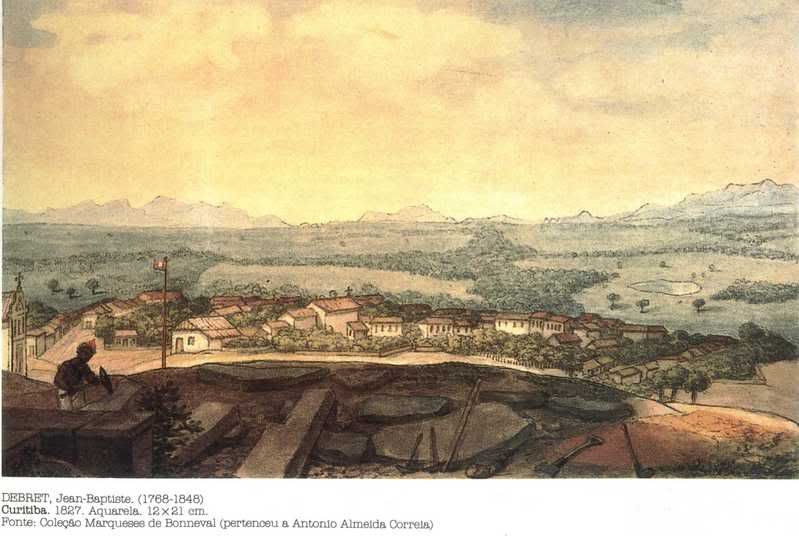
1855
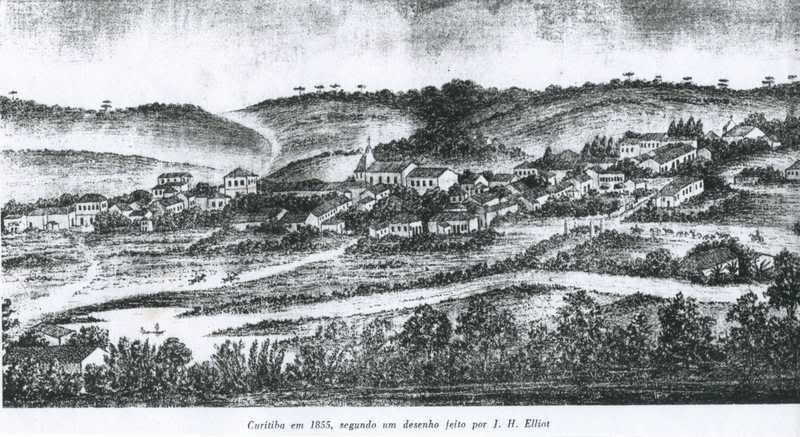
1875
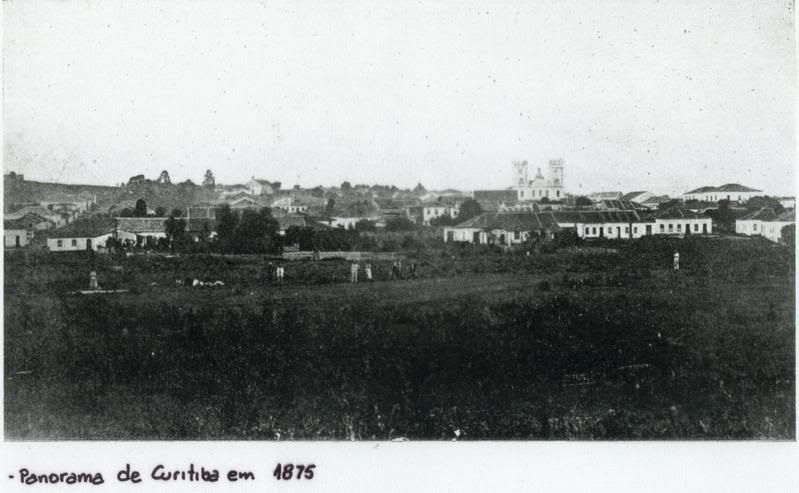
1888
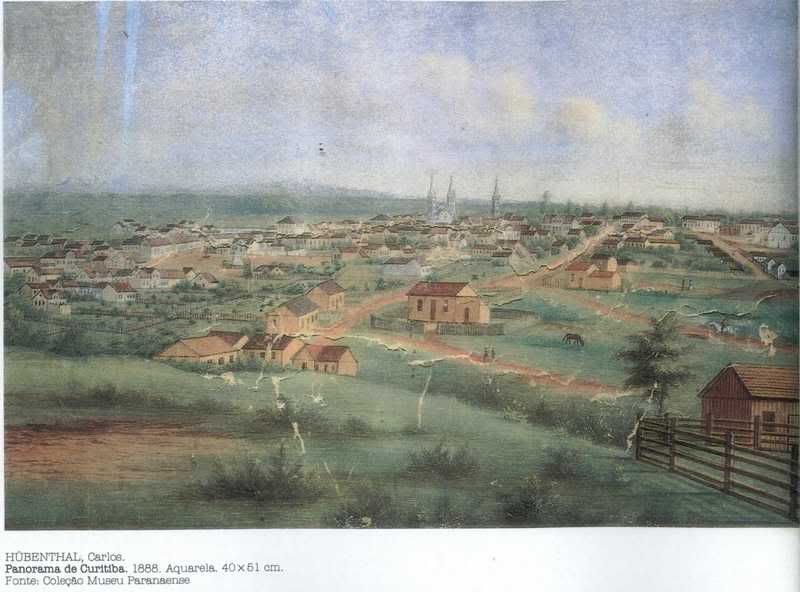
The Bandeirantes Founders Square
Catedral BasÃlica Menor de Nossa Senhora da Luz
An old Portuguese Knight Templar Inspiration that discovered the World

Old Center
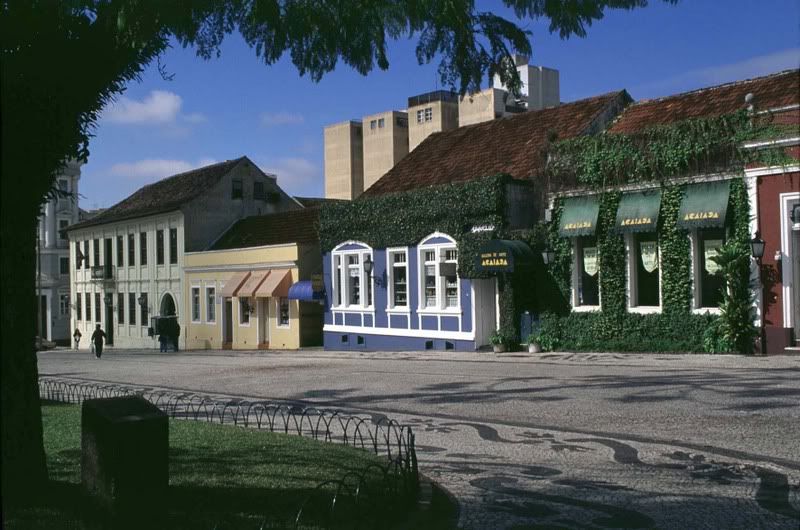
On the left Igreja de Nossa Senhora do Rosário de São Benedito, the Back Slaves Colonial Church. The building behind the Praça is Sociedade Garibaldi, an old Italian Association
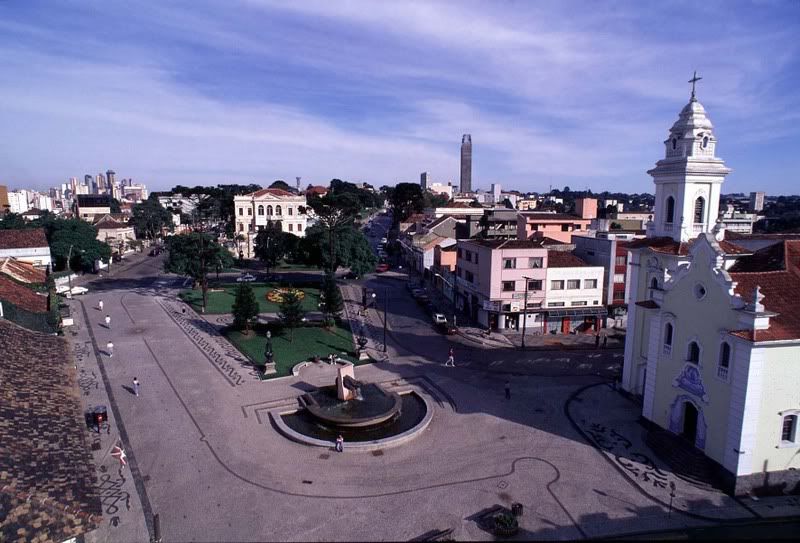
Memorial of the City
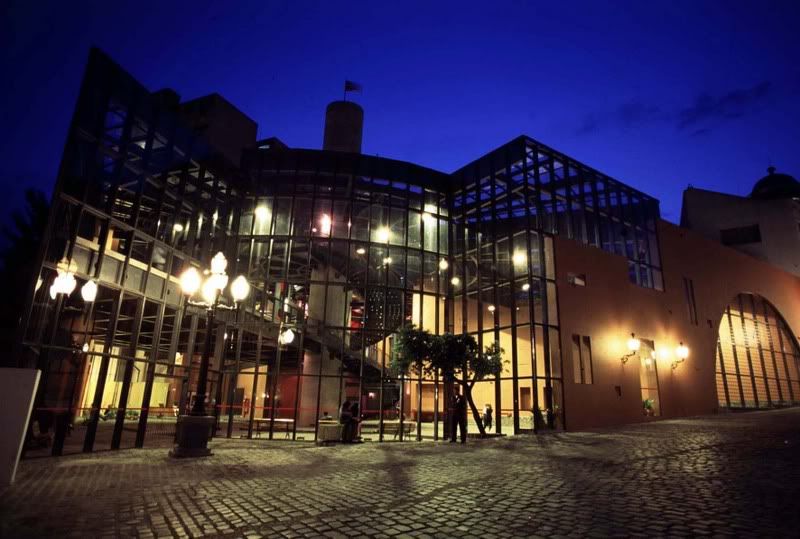
New Bairros - Bigorrilho
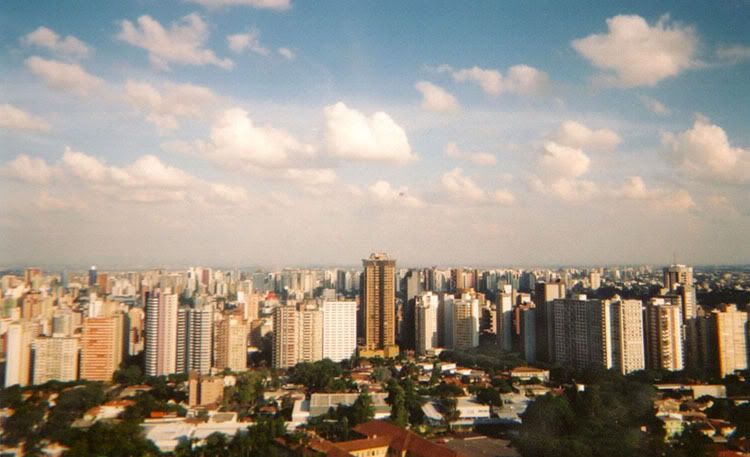
Barigüi Lake, Guaranis Indians
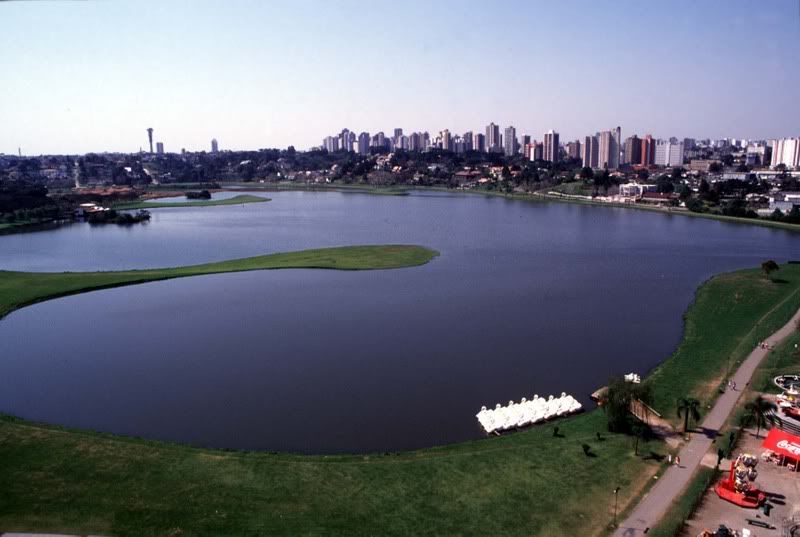
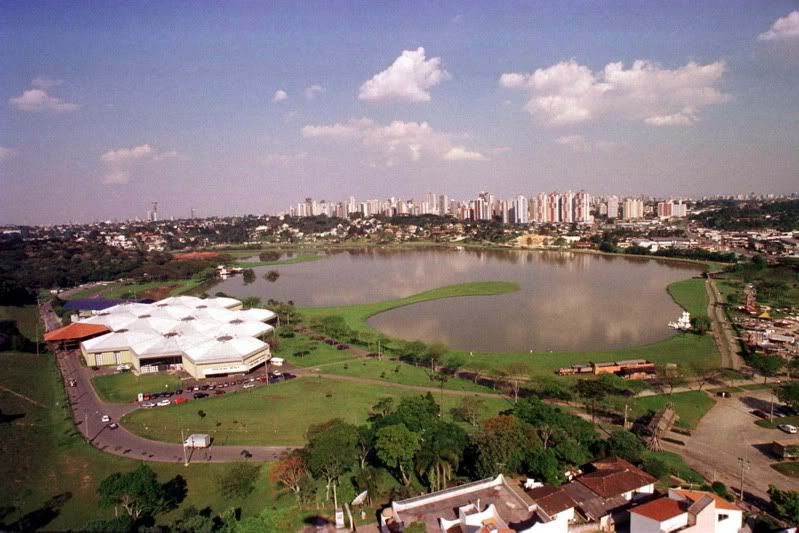
German Immigration Memorial
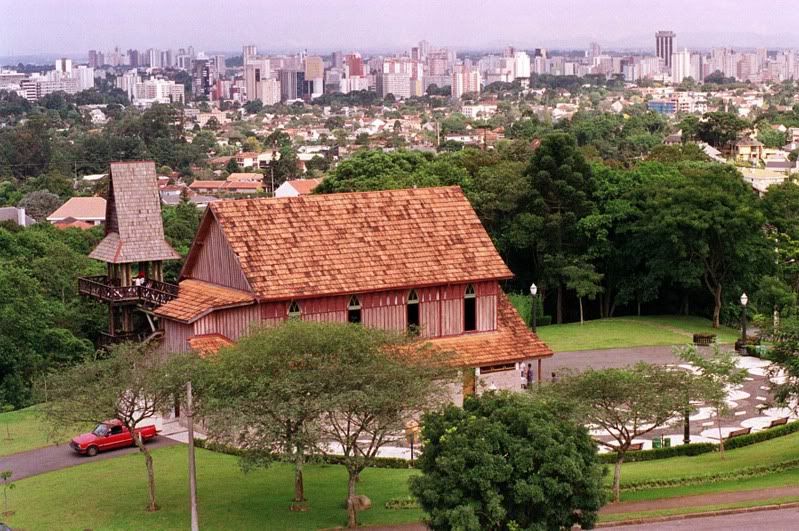
Polish Immigration Memorial - The Pope John Paul II opened it


Italian Immigration Memorial
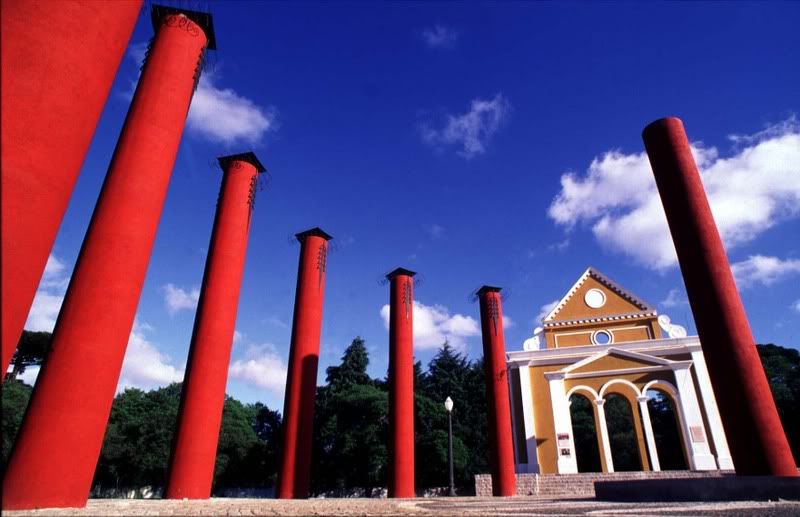

Ucranian Immigration Memorial
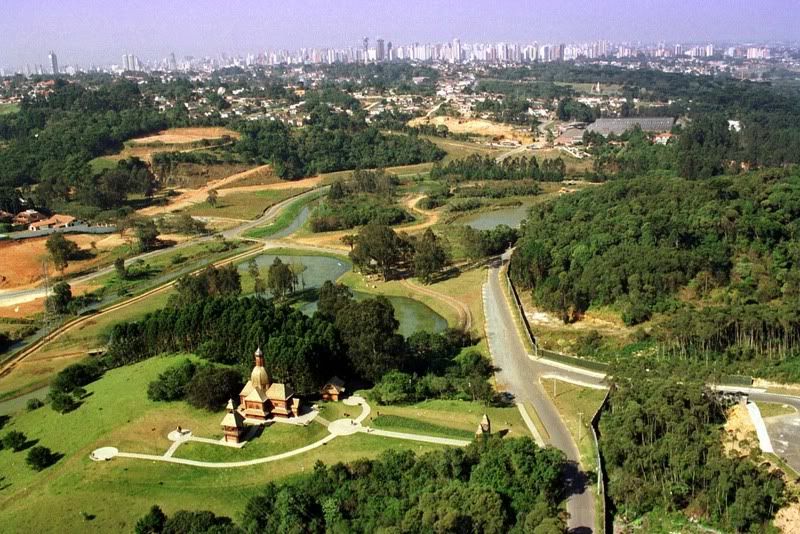
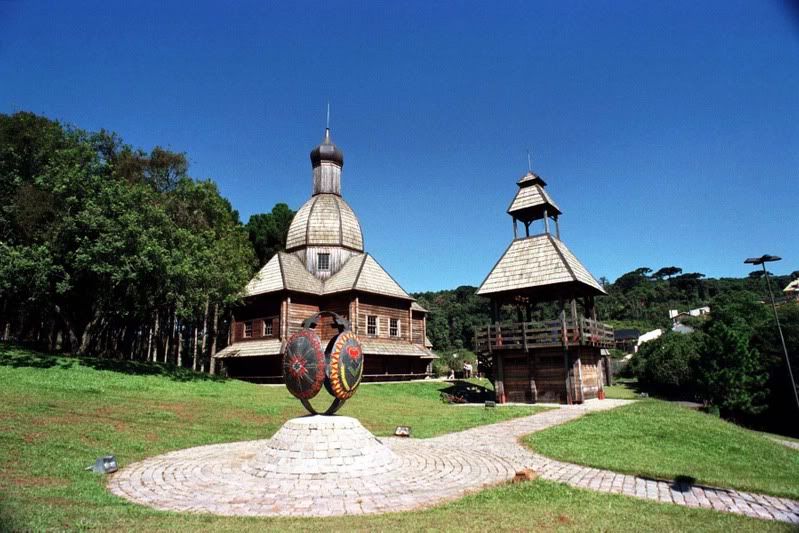
Japanese Immigration Memorial

Arab Immigration Memorial
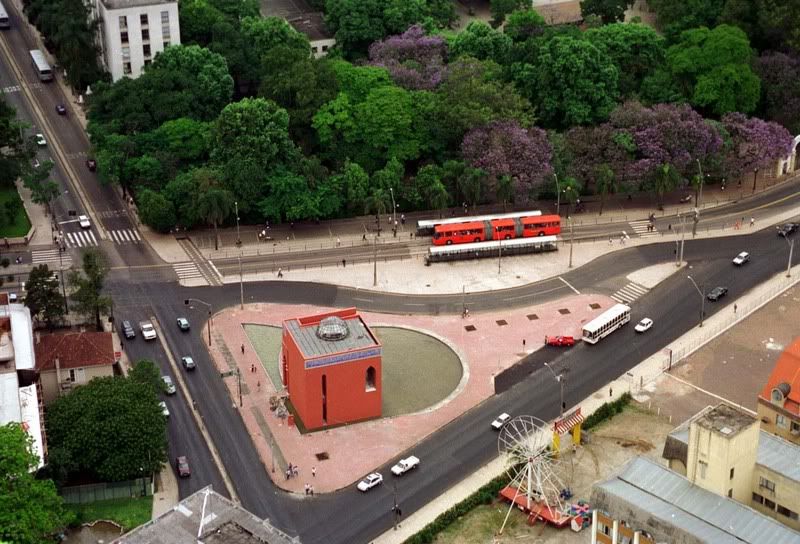
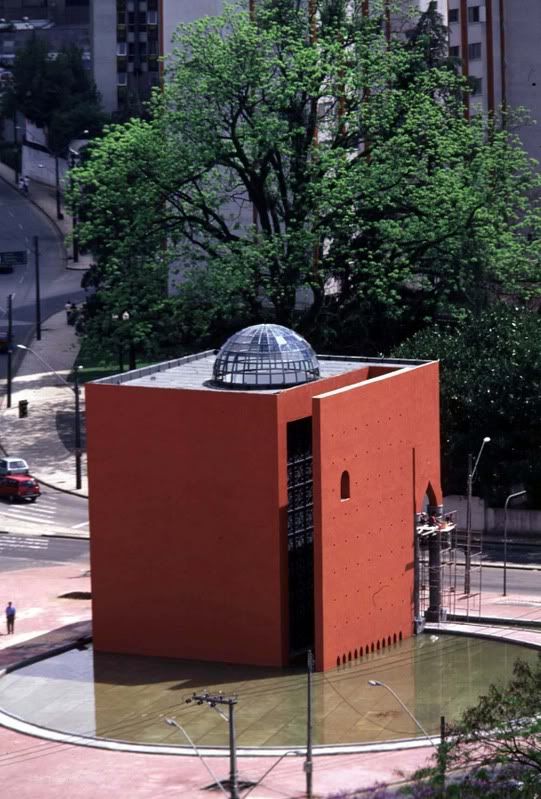
Bairro São Francisco
Catholic Churches, a Mosque, a Synaguogue and Protestant Temples in the same area
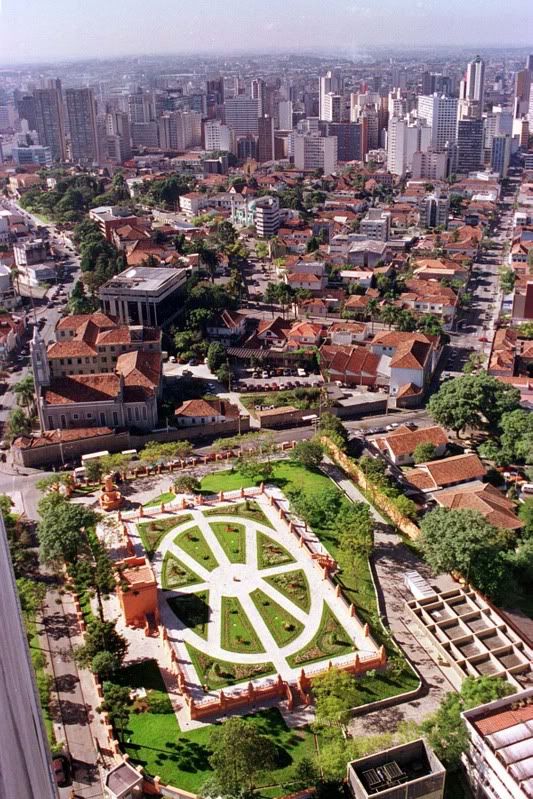
Three Angels, Three Religions
Jerusalem Fountain - Peace in the World

Complete Assimilation and Integration of the Immigrants in Brazil
One Brazilian People, Many different origins>

Conquered and Colonized by Luso-Brazilians Bandeirantes in the 1650's
Vila in 1693

African Slaves in 1827

1855

1875

1888

The Bandeirantes Founders Square
Catedral BasÃlica Menor de Nossa Senhora da Luz
An old Portuguese Knight Templar Inspiration that discovered the World

Old Center

On the left Igreja de Nossa Senhora do Rosário de São Benedito, the Back Slaves Colonial Church. The building behind the Praça is Sociedade Garibaldi, an old Italian Association

Memorial of the City

New Bairros - Bigorrilho

Barigüi Lake, Guaranis Indians


German Immigration Memorial

Polish Immigration Memorial - The Pope John Paul II opened it


Italian Immigration Memorial


Ucranian Immigration Memorial


Japanese Immigration Memorial

Arab Immigration Memorial


Bairro São Francisco
Catholic Churches, a Mosque, a Synaguogue and Protestant Temples in the same area

Three Angels, Three Religions
Jerusalem Fountain - Peace in the World

Complete Assimilation and Integration of the Immigrants in Brazil
One Brazilian People, Many different origins>
Records that your city breaks
Toronto
1.Tallest Freestanding Structure on Land
2. Longest road in the world
3. Most Multicultural City On earth
4. Most underfunded Transit system in North America
5. Most Veicles produced in North America (Golden Horseshoe)
6. by far One of the safest big cities in the world.
7. Most neighbourhoods in one city (not Metro) over 200.
8. Largest Street festival in The Americas "Caribana" 1.2 Million people attend.
9. Largest carfree community (Toronto Islands)
10. 2nd Biggest concert "Sars Stock" 470,000 people
11. One of the biggest blacouts in the world "2003 N. American Black Out"
12. Third most highrises 1,900
13. Busiest highway in North America, possibly the world. The 401, 500,000 cars.
14. 2nd Largest underground mall "Path System"
15. One of the largest Public Library Systems in the World.
16. 3rd Most theater city, second to London and NewYork
WOW... I think I'm done!!!>
1.Tallest Freestanding Structure on Land
2. Longest road in the world
3. Most Multicultural City On earth
4. Most underfunded Transit system in North America
5. Most Veicles produced in North America (Golden Horseshoe)
6. by far One of the safest big cities in the world.
7. Most neighbourhoods in one city (not Metro) over 200.
8. Largest Street festival in The Americas "Caribana" 1.2 Million people attend.
9. Largest carfree community (Toronto Islands)
10. 2nd Biggest concert "Sars Stock" 470,000 people
11. One of the biggest blacouts in the world "2003 N. American Black Out"
12. Third most highrises 1,900
13. Busiest highway in North America, possibly the world. The 401, 500,000 cars.
14. 2nd Largest underground mall "Path System"
15. One of the largest Public Library Systems in the World.
16. 3rd Most theater city, second to London and NewYork
WOW... I think I'm done!!!>
Land reclamations in your city?
Are there parts of your city undergoing or have undergone land reclamations? This is trend happening to many cities worldwide especially coastal ones.
HK is one example that has undergone massive land reclamations. Because of limited land, large population and a booming economy, massive reclamations are needed for new projects, infrastructure and developments. Such examples are the waterfronts in the north parts of HK Island, Western Kowloon, Lantau and the north parts of The New Territories.
Here are some,

A planned waterfront development along Central and Wan Chai. Reclamation along these waterfronts started during the mid-1960s and is currently expanding.

The western part of Kowloon is also undergone massive reclamation. Including is an expressway from the Western part of HK Island to the airport, residential and commercial developments including Union Square.>
HK is one example that has undergone massive land reclamations. Because of limited land, large population and a booming economy, massive reclamations are needed for new projects, infrastructure and developments. Such examples are the waterfronts in the north parts of HK Island, Western Kowloon, Lantau and the north parts of The New Territories.
Here are some,

A planned waterfront development along Central and Wan Chai. Reclamation along these waterfronts started during the mid-1960s and is currently expanding.

The western part of Kowloon is also undergone massive reclamation. Including is an expressway from the Western part of HK Island to the airport, residential and commercial developments including Union Square.>
New York City to Reward Poor for Doing Right Thing
New York City to Reward Poor for Doing Right Thing

Mayor Michael R. Bloomberg at a news conference Thursday.
By DIANE CARDWELL
Published: March 30, 2007
Seeking new solutions to New YorkÂ's vexingly high poverty rates, the city is moving ahead with an ambitious experiment that will pay poor families up to $5,000 a year to meet goals like attending parent-teacher conferences, going for a medical checkup or holding down a full-time job, Mayor Michael R. Bloomberg said yesterday.
Under the program, which is based on a similar effort in Mexico, parents would receive payments every two months for family members meeting any of a series of criteria. The payments could range from $25 for exemplary attendance in elementary school to $300 for a high score on an important exam, city officials said.
The officials said the program was the first of its kind in the country.
The project, first announced in the fall. was scheduled to begin as a pilot program in September with 2,500 randomly selected families whose progress will be tracked against another 2,500 randomly selected families who will not get the rewards. Officials planned to draw the families from six of the poorest communities in Manhattan, Brooklyn and the Bronx.
To be eligible, families must have at least one child entering fourth, seventh or ninth grade and a household income of 130 percent or less of the federal poverty level, which equals roughly $20,000 for a single parent with two children.
The city has already raised $42 million of the $50 million needed to cover the initial programÂ's cost from private sources, including Mr. Bloomberg. If it proves successful, the mayor said, the city will attempt to create a permanent program financed by the government.
Likening the payments, known as conditional cash transfers, to tax incentives that steer people of greater means toward property ownership, Mr. Bloomberg said that the approach was intended to help struggling families who often focus on basic daily survival make better long-term decisions and break generational cycles of poverty and dependence.
Â"In the private sector, financial incentives encourage actions that are good for the company: working harder, hitting sales targets or landing more clients,Â" the mayor said in an announcement at a health services center in Brownsville, Brooklyn.
Â"In the public sector, we believe that financial incentives will encourage actions that are good for the city and its families: higher attendance in schools, more parental involvement in education and better career skills.Â"
Since Mr. Bloomberg outlined the plan last fall, reaction among antipoverty experts and advocates has been mixed, with some hailing it as an innovative approach that could become a powerful model for the rest of the country and ultimately win the support of the federal government.
Indeed, the program is being financed by several high-profile organizations, including the Rockefeller, Starr and Robin Hood Foundations, as well as the Open Society Institute and the insurance and financial firm American International Group.
The Rockefeller and Starr Foundations are donating $10 million each, while the Open Society Institute is giving $5 million and A.I.G. is donating $2 million. A spokeswoman for the Robin Hood Foundation did not return calls or an e-mail message, and Mr. BloombergÂ's spokesman, Stu Loeser, declined to say how much the mayor contributed.
Some antipoverty advocates have bristled at what they see as the condescending notion that poor people need to be told how to raise their families. Others have focused on the broader economic issues at play.
Â"It is encouraging that the mayor believes thereÂ's a public role for addressing intergenerational poverty, inequality and economic mobility,Â" said Margy Waller, a former Clinton administration adviser who is a co-founder of Inclusion, a research and policy group based in Washington.
Â"What is troubling is the focus on personal behavior as the solution to what is at least in part a problem of the economy,Â" she said. Â"Given what we know about the growth of low-wage jobs and the shrinking of the middle class, it will be, in fact, impossible to bring more people into the middle class unless we improve the labor market as well.Â"
A similar concern seems to have emerged with MexicoÂ's program, known as Oportunidades, which is now 10 years old, has a budget of more than $3 billion a year and covers nearly one-fourth of all Mexicans.
Intended to replace the food subsidies that had dominated much of MexicoÂ's antipoverty efforts, the program offers cash stipends to families to keep their children in school and take them for regular checkups. Parents must also attend regular talks on issues including health, nutrition and family planning.
Outside evaluations have found that the program has been successful in raising school attendance and nutrition levels and that the percentage of Mexicans living in extreme poverty has fallen.
Still, there are questions about how much more effective the program can be in lifting large numbers of people permanently out of poverty, in part because jobs are lacking.
In January, Santiago Levy, one of the programÂ's creators and a former undersecretary of finance in Mexico, said at the Brookings Institution in Washington that even if the program were 100 percent effective, it alone could not solve the problem.
Â"NowÂ's heÂ's out with a high school degree, a healthy man: Is he going to get a job or migrate to the U.S.?Â" he said.
But others see cause for optimism in the results of MexicoÂ's program and similar ones in other Latin American countries. In Nicaragua, for example, primary school enrollment rates grew to 90 percent from 68 percent; in Colombia, secondary school enrollment in urban areas rose to 78 percent from 64 percent, said Laura Rawlings, a World Bank specialist who has studied the programs, which she said are active or being created in nearly 20 countries.
The idea to try the program in New York has its roots in the broad attack on poverty that Mr. Bloomberg has made a high-profile cause for his second term. Roughly one in five New Yorkers lives in poverty, according to the Community Service Society of New York.
In keeping with the administrationÂ's emphasis on outcomes, city officials say they will closely monitor the test groupÂ's progress against that of the control group with the help of M.D.R.C., a nonprofit policy research organization involved in the programÂ's design.
All 5,000 families will be asked to agree to participate in the program before knowing which group they are in, said Gordon Berlin, the president of M.D.R.C., and those not receiving benefits will be paid a nominal fee to submit to monitoring and surveys, he said.
Officials expect that some of the control families will inevitably drop out, but Mr. Berlin said that in conducting similar experiments in the past, he had found that most were willing to participate even without the benefits because they were informed that it would help guide a government policy decision in which they had a stake.
The families receiving the benefits will be given a list of goals they are expected to meet, as well as the values assigned to them. They will also get a Â"passportÂ" for documenting the completion of tasks that are not automatically reported elsewhere, said Linda I. Gibbs, the deputy mayor overseeing the effort.
The city is working with state and federal officials, Ms. Gibbs said, to make sure that families do not lose other benefits because of the grants.
Copyright 2007 The New York Times Company>

Mayor Michael R. Bloomberg at a news conference Thursday.
By DIANE CARDWELL
Published: March 30, 2007
Seeking new solutions to New YorkÂ's vexingly high poverty rates, the city is moving ahead with an ambitious experiment that will pay poor families up to $5,000 a year to meet goals like attending parent-teacher conferences, going for a medical checkup or holding down a full-time job, Mayor Michael R. Bloomberg said yesterday.
Under the program, which is based on a similar effort in Mexico, parents would receive payments every two months for family members meeting any of a series of criteria. The payments could range from $25 for exemplary attendance in elementary school to $300 for a high score on an important exam, city officials said.
The officials said the program was the first of its kind in the country.
The project, first announced in the fall. was scheduled to begin as a pilot program in September with 2,500 randomly selected families whose progress will be tracked against another 2,500 randomly selected families who will not get the rewards. Officials planned to draw the families from six of the poorest communities in Manhattan, Brooklyn and the Bronx.
To be eligible, families must have at least one child entering fourth, seventh or ninth grade and a household income of 130 percent or less of the federal poverty level, which equals roughly $20,000 for a single parent with two children.
The city has already raised $42 million of the $50 million needed to cover the initial programÂ's cost from private sources, including Mr. Bloomberg. If it proves successful, the mayor said, the city will attempt to create a permanent program financed by the government.
Likening the payments, known as conditional cash transfers, to tax incentives that steer people of greater means toward property ownership, Mr. Bloomberg said that the approach was intended to help struggling families who often focus on basic daily survival make better long-term decisions and break generational cycles of poverty and dependence.
Â"In the private sector, financial incentives encourage actions that are good for the company: working harder, hitting sales targets or landing more clients,Â" the mayor said in an announcement at a health services center in Brownsville, Brooklyn.
Â"In the public sector, we believe that financial incentives will encourage actions that are good for the city and its families: higher attendance in schools, more parental involvement in education and better career skills.Â"
Since Mr. Bloomberg outlined the plan last fall, reaction among antipoverty experts and advocates has been mixed, with some hailing it as an innovative approach that could become a powerful model for the rest of the country and ultimately win the support of the federal government.
Indeed, the program is being financed by several high-profile organizations, including the Rockefeller, Starr and Robin Hood Foundations, as well as the Open Society Institute and the insurance and financial firm American International Group.
The Rockefeller and Starr Foundations are donating $10 million each, while the Open Society Institute is giving $5 million and A.I.G. is donating $2 million. A spokeswoman for the Robin Hood Foundation did not return calls or an e-mail message, and Mr. BloombergÂ's spokesman, Stu Loeser, declined to say how much the mayor contributed.
Some antipoverty advocates have bristled at what they see as the condescending notion that poor people need to be told how to raise their families. Others have focused on the broader economic issues at play.
Â"It is encouraging that the mayor believes thereÂ's a public role for addressing intergenerational poverty, inequality and economic mobility,Â" said Margy Waller, a former Clinton administration adviser who is a co-founder of Inclusion, a research and policy group based in Washington.
Â"What is troubling is the focus on personal behavior as the solution to what is at least in part a problem of the economy,Â" she said. Â"Given what we know about the growth of low-wage jobs and the shrinking of the middle class, it will be, in fact, impossible to bring more people into the middle class unless we improve the labor market as well.Â"
A similar concern seems to have emerged with MexicoÂ's program, known as Oportunidades, which is now 10 years old, has a budget of more than $3 billion a year and covers nearly one-fourth of all Mexicans.
Intended to replace the food subsidies that had dominated much of MexicoÂ's antipoverty efforts, the program offers cash stipends to families to keep their children in school and take them for regular checkups. Parents must also attend regular talks on issues including health, nutrition and family planning.
Outside evaluations have found that the program has been successful in raising school attendance and nutrition levels and that the percentage of Mexicans living in extreme poverty has fallen.
Still, there are questions about how much more effective the program can be in lifting large numbers of people permanently out of poverty, in part because jobs are lacking.
In January, Santiago Levy, one of the programÂ's creators and a former undersecretary of finance in Mexico, said at the Brookings Institution in Washington that even if the program were 100 percent effective, it alone could not solve the problem.
Â"NowÂ's heÂ's out with a high school degree, a healthy man: Is he going to get a job or migrate to the U.S.?Â" he said.
But others see cause for optimism in the results of MexicoÂ's program and similar ones in other Latin American countries. In Nicaragua, for example, primary school enrollment rates grew to 90 percent from 68 percent; in Colombia, secondary school enrollment in urban areas rose to 78 percent from 64 percent, said Laura Rawlings, a World Bank specialist who has studied the programs, which she said are active or being created in nearly 20 countries.
The idea to try the program in New York has its roots in the broad attack on poverty that Mr. Bloomberg has made a high-profile cause for his second term. Roughly one in five New Yorkers lives in poverty, according to the Community Service Society of New York.
In keeping with the administrationÂ's emphasis on outcomes, city officials say they will closely monitor the test groupÂ's progress against that of the control group with the help of M.D.R.C., a nonprofit policy research organization involved in the programÂ's design.
All 5,000 families will be asked to agree to participate in the program before knowing which group they are in, said Gordon Berlin, the president of M.D.R.C., and those not receiving benefits will be paid a nominal fee to submit to monitoring and surveys, he said.
Officials expect that some of the control families will inevitably drop out, but Mr. Berlin said that in conducting similar experiments in the past, he had found that most were willing to participate even without the benefits because they were informed that it would help guide a government policy decision in which they had a stake.
The families receiving the benefits will be given a list of goals they are expected to meet, as well as the values assigned to them. They will also get a Â"passportÂ" for documenting the completion of tasks that are not automatically reported elsewhere, said Linda I. Gibbs, the deputy mayor overseeing the effort.
The city is working with state and federal officials, Ms. Gibbs said, to make sure that families do not lose other benefits because of the grants.
Copyright 2007 The New York Times Company>
Hong Kong is beating off Shanghai to dominate China's finance
Contrary to rumors about its imminent "death" following the transfer of power from the British, Hong Kong has emerged as the financial intermediary through which foreign investors seek to invest tens of billions of dollars into mainland China. Meanwhile, once-booming Shanghai's star is starting to fade. What happened? According to Wharton faculty and other experts, while Hong Kong was crafting a strategy to position the city as both a legal and financial services center for China, Shanghai was weighed down by corruption and a largely state-run financial services sector.
Out of Shanghai's shadow: Why Hong Kong is becoming China's Financial Services Center
http://knowledge.wharton.upenn.edu/a...TOKEN=19698621
Published: November 15, 2006 in Knowledge@Wharton
It's a city-state of seven million people, with skyscrapers wrapped around a picturesque harbor and an in-your-face brand of capitalism. But it wasn't long ago that economic obituaries were being written about Hong Kong: A June 1995 story in Fortune magazine was titled, not-too-subtly, "The Death of Hong Kong."
As the reasoning went, Hong Kong would fade in economic dynamism when the British lease expired and the island reverted to Communist control in June 1997. Under an agreement between Margaret Thatcher's government and China, Beijing vowed to give Hong Kong substantial freedoms, except in foreign and defense affairs, until 2047 -- 50 years after the handover. Observers doubted the hands-off promise, fearing that Hong Kong would become "a captive colony of Beijing ... just another mainland city, governed by corruption and political connections rather than the even-handed rule of law," as the Fortune piece stated.
At the same time, Beijing's patronage shifted to Shanghai, the gateway to China's interior. According to John Zhang, professor of marketing at Wharton, Shanghai had been the preeminent financial and commercial center in China in the 1920s and 1930s before the Communists came to power, and the city aspired to return to the role. "China had every intention of building up Shanghai as the financial center for all of Asia," he says.
Yet reports of Hong Kong's death were greatly exaggerated. In a resurgence noted recently by Time's Asia edition and others, Hong Kong has emerged as the financial intermediary through which foreign investors seek to invest tens of billions of dollars into mainland China. Meanwhile, Shanghai's star has started to fade. What happened? According to Wharton faculty and other experts, while Hong Kong was crafting a strategy to position the city as both a legal and financial services center for China, Shanghai was weighed down by corruption and a largely state-run financial services sector.
The Favored Child
As China entered the 1990s, Shanghai was largely untouched by modern ideas of capitalism and political freedoms, thereby making it a more amenable place than Hong Kong for national leaders and economic growth policies. Shanghai also had a powerful political clique pulling strings with Communist bureaucrats. Massive public works projects were started, including a shipping port to rival Hong Kong's. An international crowd gathered in this most Western of mainland Chinese cities, while foreign money in factories, real estate and tech centers flowed in. As one major U.S. newsweekly noted, "Shanghai was the favored child.... Hong Kong was in the shadows."
"[Shanghai] was the place where capital was to be raised in China," says Marshall W. Meyer, professor of management at Wharton. "In the mid-1990s, there was an assumption that Shanghai would absorb the Hong Kong stock exchange.... Shanghai was allowed to develop its own self-contained economy, like Singapore. Tax policies favorable to Shanghai were developed, and Shanghai boomed."
In response, Hong Kong officials worked to bolster the city's position by emphasizing Hong Kong's rule of law and its British-based court system, anti-corruption measures and U.S.-like securities laws. Officials like Justice Secretary Wong Lan Lung lobbied to make Hong Kong the place to resolve business disputes on both the mainland and in the city itself, an effort that has produced some results.
Ingratiating itself in Beijing, Hong Kong made an all-out effort to influence Communist leaders so that its needs weren't neglected. And where laws permitted, Hong Kong attempted to integrate itself with mainland China. For instance, Hong Kong officials say they allow thousands of pregnant mainland Chinese women to enter Hong Kong each year to give birth in the city's well-run hospitals. Mainland Chinese banks have expanded in Hong Kong, and both Hong Kong and Chinese currencies are accepted in Hong Kong businesses. Meanwhile, China has scheduled polo events for the 2008 Beijing Olympics in Hong Kong.
Private groups, such as the Better Hong Kong Foundation and the Vision 2047 Foundation, were organized by businesspeople, bankers, asset managers, real estate tycoons and local leaders to promote Hong Kong and address negative perceptions in the West. "The fear was that Hong Kong would be marginalized. At this stage, I can [guarantee] that Hong Kong will not be marginalized," says Vision 2047 member David Dodwell, chief executive of Strategic Access, a Hong Kong consulting company, and co-author of the book The Hong Kong Advantage. Stephen Brown, another Vision 2047 member, in a breakfast meeting with foreign journalists, added: "Shanghai's star is not shining as brightly as it was a few years ago."
Indeed, billions of dollars in foreign investment that might have gone directly to China are now being funneled through Hong Kong, in part because of the Closer Economic Partnership Arrangement, or CEPA, a free trade agreement signed in 2003 between Hong Kong and the mainland. English is widely spoken in Hong Kong, so doing business there is easier for Western companies than in China. In addition, Chinese corporate executives are now seeking to tap robust international capital markets in Hong Kong instead of Shanghai's weaker capital markets.
One example: In mid-October, China's largest bank, the Industrial and Commercial Bank of China, raised $19 billion in the world's largest initial public offering, dividing the offering between Hong Kong and Shanghai. The share that went to Hong Kong: $13.9 billion. The share that went to Shanghai: $5.1 billion. Other large mainland China banks that have listed on the Hong Kong exchange include the Bank of China and the China Construction Bank. They are among dozens of mainland Chinese companies -- called "Red Chips" -- listed on the Hong Kong exchange, which has internationally recognized regulations.
A Window to the World
What caused the reversal of fortunes? Shanghai wasn't ready for the big time, say experts. Its financial services companies -- typically state-run -- and stock brokerages were unsophisticated. Shanghai stock brokerages went bankrupt after promising returns on stocks that tanked. Big-money investors weren't comfortable with weak accounting rules and Chinese market regulation. Chinese laws, meanwhile, restrict the granting of stock options to executives and directors. This has partly encouraged Chinese companies to float stock in Hong Kong through Hong Kong-registered holding companies.
"Most of the listed companies are state-owned. If you are a state-owned company listed in Shanghai you can't give your executives or directors [stock] options," Meyer says. "The Shanghai stock market has been on a long downhill slope for some time ... it also almost looks as if China has outsourced its capital markets to Hong Kong." He notes that the amount of capital raised on the Hong Kong stock exchange in the first half of 2006 -- fueled by Chinese company listings -- was greater than the amount raised in New York.
Shanghai faces other problems as well. A political backlash in the form of an investigation into local corruption has snared local political bosses. In September, the central government fired Shanghai Party Secretary Chen Liangyu for his alleged involvement in the mismanagement of the city's Social Security fund. Many others are being investigated. It was a stunning political move by President Hu Jintao, who is not from Shanghai and is consolidating national power. "No matter who, no matter how high their post, those who violate party discipline and state laws will receive serious investigation and severe punishment," the state-controlled news agency Xinhua quoted the Community Party Central Committee as saying.
The investigations "already show that Shanghai will not receive the favorable treatment it has in the past," Meyer notes, adding that Beijing wants to prevent endemic corruption. The government has proposed moving local officials around the country to prevent them from building individual political networks.
Yet according to Zhang, Shanghai still has a big part to play in China's economy. Multinational companies have invested billions in factories and research centers there. Some investment is export-oriented and some is focused on developing local products for the Chinese market. But Beijing also has learned in the last decade that "Hong Kong is a window to the rest of the world.... There is an advantage to keeping Hong Kong prosperous and not overshadowing it." Hong Kong has a deep talent pool of lawyers, accountants, traders, analysts and economists that can't be easily replicated in Shanghai, he adds.
Mike Rowse, Hong Kong's director general of investment promotion, can barely contain his glee over the Hong Kong bounce. "We found a new lease on life," he says, noting that last year $35.9 billion in foreign direct investment came into Hong Kong, making it one of the world's largest recipients of FDI. Hong Kong doesn't track exactly where all this money goes, but it's believed that a healthy portion is eventually funneled into mainland China, with Hong Kong businesses acting as intermediaries. According to government statistics, Hong Kong entities are the largest external investors in mainland China, accounting for 43%, or $245 billion, of cumulative foreign direct investment.
Hong Kong's economy grew at about 8% last year -- not bad for a mature economy that lost nearly all its manufacturing base over the last 15 years as businesses sought dirt-cheap factory labor on the Chinese mainland. "We don't need the manufacturing," Rowse says. "We do manufacturing where it makes sense to do it.... The manufacturing is never coming back. I have to be careful where I say this in Hong Kong because there are some who still think it will. But it's not." As for Shanghai, he says China is a big country and there is room for both cities to succeed. At the same time, he adds, "people are getting a bit more realistic about what you can do in Shanghai."
With about 90% of its economic output in services, Hong Kong has other issues to deal with. One of its biggest current problems didn't even exist five years ago -- pollution. Favorable breezes act like "down" escalators transporting the smoke of about 200,000 factories in the Pearl River Delta into Hong Kong. American executives complain that they have trouble recruiting and keeping talented managers there because of the smog and air pollution. The 2,000-member American Chamber of Commerce in Hong Kong says U.S. companies have invested $30 billion in Hong Kong, but families don't want to put their kids through a childhood of toxic air.
Todd Hodgson, a vice president with Time Warner, recently recounted to a Wall Street Journal reporter how he relocated his family to Australia from Hong Kong in August. He said his two young children, ages three and six, were constantly in the doctor's office in Hong Kong for asthma and lung ailments. "The money and perks just weren't enough to keep us there anymore," Hodgson said. "You can drink bottled water. But with the air -- you have to breathe it."
Environmental officials in Hong Kong have begun working more closely with mainland Chinese authorities and are posting pollution data on public access web sites. They have also sharply criticized Exxon Mobil for failing to install equipment to clean the smoke from dirty coal-burning electric units that supply Hong Kong with electricity.
"This is part of economic development," Rowse says. "Forty years ago, there were oxygen tanks on the streets in Tokyo. They cleaned it up." Hong Kong can't point its finger at China for air pollution "because much of it is coming from Hong Kong-owned factories. We're not innocent here." As for the threat of pollution to the city's growth, "Individual executives are very critical of the air, but the companies still know they have to be in Hong Kong to earn a profit.">
Out of Shanghai's shadow: Why Hong Kong is becoming China's Financial Services Center
http://knowledge.wharton.upenn.edu/a...TOKEN=19698621
Published: November 15, 2006 in Knowledge@Wharton
It's a city-state of seven million people, with skyscrapers wrapped around a picturesque harbor and an in-your-face brand of capitalism. But it wasn't long ago that economic obituaries were being written about Hong Kong: A June 1995 story in Fortune magazine was titled, not-too-subtly, "The Death of Hong Kong."
As the reasoning went, Hong Kong would fade in economic dynamism when the British lease expired and the island reverted to Communist control in June 1997. Under an agreement between Margaret Thatcher's government and China, Beijing vowed to give Hong Kong substantial freedoms, except in foreign and defense affairs, until 2047 -- 50 years after the handover. Observers doubted the hands-off promise, fearing that Hong Kong would become "a captive colony of Beijing ... just another mainland city, governed by corruption and political connections rather than the even-handed rule of law," as the Fortune piece stated.
At the same time, Beijing's patronage shifted to Shanghai, the gateway to China's interior. According to John Zhang, professor of marketing at Wharton, Shanghai had been the preeminent financial and commercial center in China in the 1920s and 1930s before the Communists came to power, and the city aspired to return to the role. "China had every intention of building up Shanghai as the financial center for all of Asia," he says.
Yet reports of Hong Kong's death were greatly exaggerated. In a resurgence noted recently by Time's Asia edition and others, Hong Kong has emerged as the financial intermediary through which foreign investors seek to invest tens of billions of dollars into mainland China. Meanwhile, Shanghai's star has started to fade. What happened? According to Wharton faculty and other experts, while Hong Kong was crafting a strategy to position the city as both a legal and financial services center for China, Shanghai was weighed down by corruption and a largely state-run financial services sector.
The Favored Child
As China entered the 1990s, Shanghai was largely untouched by modern ideas of capitalism and political freedoms, thereby making it a more amenable place than Hong Kong for national leaders and economic growth policies. Shanghai also had a powerful political clique pulling strings with Communist bureaucrats. Massive public works projects were started, including a shipping port to rival Hong Kong's. An international crowd gathered in this most Western of mainland Chinese cities, while foreign money in factories, real estate and tech centers flowed in. As one major U.S. newsweekly noted, "Shanghai was the favored child.... Hong Kong was in the shadows."
"[Shanghai] was the place where capital was to be raised in China," says Marshall W. Meyer, professor of management at Wharton. "In the mid-1990s, there was an assumption that Shanghai would absorb the Hong Kong stock exchange.... Shanghai was allowed to develop its own self-contained economy, like Singapore. Tax policies favorable to Shanghai were developed, and Shanghai boomed."
In response, Hong Kong officials worked to bolster the city's position by emphasizing Hong Kong's rule of law and its British-based court system, anti-corruption measures and U.S.-like securities laws. Officials like Justice Secretary Wong Lan Lung lobbied to make Hong Kong the place to resolve business disputes on both the mainland and in the city itself, an effort that has produced some results.
Ingratiating itself in Beijing, Hong Kong made an all-out effort to influence Communist leaders so that its needs weren't neglected. And where laws permitted, Hong Kong attempted to integrate itself with mainland China. For instance, Hong Kong officials say they allow thousands of pregnant mainland Chinese women to enter Hong Kong each year to give birth in the city's well-run hospitals. Mainland Chinese banks have expanded in Hong Kong, and both Hong Kong and Chinese currencies are accepted in Hong Kong businesses. Meanwhile, China has scheduled polo events for the 2008 Beijing Olympics in Hong Kong.
Private groups, such as the Better Hong Kong Foundation and the Vision 2047 Foundation, were organized by businesspeople, bankers, asset managers, real estate tycoons and local leaders to promote Hong Kong and address negative perceptions in the West. "The fear was that Hong Kong would be marginalized. At this stage, I can [guarantee] that Hong Kong will not be marginalized," says Vision 2047 member David Dodwell, chief executive of Strategic Access, a Hong Kong consulting company, and co-author of the book The Hong Kong Advantage. Stephen Brown, another Vision 2047 member, in a breakfast meeting with foreign journalists, added: "Shanghai's star is not shining as brightly as it was a few years ago."
Indeed, billions of dollars in foreign investment that might have gone directly to China are now being funneled through Hong Kong, in part because of the Closer Economic Partnership Arrangement, or CEPA, a free trade agreement signed in 2003 between Hong Kong and the mainland. English is widely spoken in Hong Kong, so doing business there is easier for Western companies than in China. In addition, Chinese corporate executives are now seeking to tap robust international capital markets in Hong Kong instead of Shanghai's weaker capital markets.
One example: In mid-October, China's largest bank, the Industrial and Commercial Bank of China, raised $19 billion in the world's largest initial public offering, dividing the offering between Hong Kong and Shanghai. The share that went to Hong Kong: $13.9 billion. The share that went to Shanghai: $5.1 billion. Other large mainland China banks that have listed on the Hong Kong exchange include the Bank of China and the China Construction Bank. They are among dozens of mainland Chinese companies -- called "Red Chips" -- listed on the Hong Kong exchange, which has internationally recognized regulations.
A Window to the World
What caused the reversal of fortunes? Shanghai wasn't ready for the big time, say experts. Its financial services companies -- typically state-run -- and stock brokerages were unsophisticated. Shanghai stock brokerages went bankrupt after promising returns on stocks that tanked. Big-money investors weren't comfortable with weak accounting rules and Chinese market regulation. Chinese laws, meanwhile, restrict the granting of stock options to executives and directors. This has partly encouraged Chinese companies to float stock in Hong Kong through Hong Kong-registered holding companies.
"Most of the listed companies are state-owned. If you are a state-owned company listed in Shanghai you can't give your executives or directors [stock] options," Meyer says. "The Shanghai stock market has been on a long downhill slope for some time ... it also almost looks as if China has outsourced its capital markets to Hong Kong." He notes that the amount of capital raised on the Hong Kong stock exchange in the first half of 2006 -- fueled by Chinese company listings -- was greater than the amount raised in New York.
Shanghai faces other problems as well. A political backlash in the form of an investigation into local corruption has snared local political bosses. In September, the central government fired Shanghai Party Secretary Chen Liangyu for his alleged involvement in the mismanagement of the city's Social Security fund. Many others are being investigated. It was a stunning political move by President Hu Jintao, who is not from Shanghai and is consolidating national power. "No matter who, no matter how high their post, those who violate party discipline and state laws will receive serious investigation and severe punishment," the state-controlled news agency Xinhua quoted the Community Party Central Committee as saying.
The investigations "already show that Shanghai will not receive the favorable treatment it has in the past," Meyer notes, adding that Beijing wants to prevent endemic corruption. The government has proposed moving local officials around the country to prevent them from building individual political networks.
Yet according to Zhang, Shanghai still has a big part to play in China's economy. Multinational companies have invested billions in factories and research centers there. Some investment is export-oriented and some is focused on developing local products for the Chinese market. But Beijing also has learned in the last decade that "Hong Kong is a window to the rest of the world.... There is an advantage to keeping Hong Kong prosperous and not overshadowing it." Hong Kong has a deep talent pool of lawyers, accountants, traders, analysts and economists that can't be easily replicated in Shanghai, he adds.
Mike Rowse, Hong Kong's director general of investment promotion, can barely contain his glee over the Hong Kong bounce. "We found a new lease on life," he says, noting that last year $35.9 billion in foreign direct investment came into Hong Kong, making it one of the world's largest recipients of FDI. Hong Kong doesn't track exactly where all this money goes, but it's believed that a healthy portion is eventually funneled into mainland China, with Hong Kong businesses acting as intermediaries. According to government statistics, Hong Kong entities are the largest external investors in mainland China, accounting for 43%, or $245 billion, of cumulative foreign direct investment.
Hong Kong's economy grew at about 8% last year -- not bad for a mature economy that lost nearly all its manufacturing base over the last 15 years as businesses sought dirt-cheap factory labor on the Chinese mainland. "We don't need the manufacturing," Rowse says. "We do manufacturing where it makes sense to do it.... The manufacturing is never coming back. I have to be careful where I say this in Hong Kong because there are some who still think it will. But it's not." As for Shanghai, he says China is a big country and there is room for both cities to succeed. At the same time, he adds, "people are getting a bit more realistic about what you can do in Shanghai."
With about 90% of its economic output in services, Hong Kong has other issues to deal with. One of its biggest current problems didn't even exist five years ago -- pollution. Favorable breezes act like "down" escalators transporting the smoke of about 200,000 factories in the Pearl River Delta into Hong Kong. American executives complain that they have trouble recruiting and keeping talented managers there because of the smog and air pollution. The 2,000-member American Chamber of Commerce in Hong Kong says U.S. companies have invested $30 billion in Hong Kong, but families don't want to put their kids through a childhood of toxic air.
Todd Hodgson, a vice president with Time Warner, recently recounted to a Wall Street Journal reporter how he relocated his family to Australia from Hong Kong in August. He said his two young children, ages three and six, were constantly in the doctor's office in Hong Kong for asthma and lung ailments. "The money and perks just weren't enough to keep us there anymore," Hodgson said. "You can drink bottled water. But with the air -- you have to breathe it."
Environmental officials in Hong Kong have begun working more closely with mainland Chinese authorities and are posting pollution data on public access web sites. They have also sharply criticized Exxon Mobil for failing to install equipment to clean the smoke from dirty coal-burning electric units that supply Hong Kong with electricity.
"This is part of economic development," Rowse says. "Forty years ago, there were oxygen tanks on the streets in Tokyo. They cleaned it up." Hong Kong can't point its finger at China for air pollution "because much of it is coming from Hong Kong-owned factories. We're not innocent here." As for the threat of pollution to the city's growth, "Individual executives are very critical of the air, but the companies still know they have to be in Hong Kong to earn a profit.">
GaWC - Inventory of WORLD CITIES
I've just read a book by Jane Jacobs and she talked about Global Cities, and researching on the Internet I just found this website. I think it's quite interesting rating major cities from most global to less globalized. I think some cities are a little underrated, rating Shanghai only 4 points or Mumbai 3, and other are overrated (Brussels 8 points¡). I was surprised about founding Tashkent, Tijuana or Bologna as global cities (even with minimal evidence and 1 point). What u think?
http://www.lboro.ac.uk/gawc/citylist.html
A. ALPHA WORLD CITIES (full service world cities)
12: London, New York, Paris, Tokyo
10: Chicago, Frankfurt, Hong Kong, Los Angeles, Milan, Singapore
B. BETA WORLD CITIES (major world cities)
9: San Francisco, Sydney, Toronto, Zurich
8: Brussels, Madrid, Mexico City, Sao Paulo
7: Moscow, Seoul
C. GAMMA WORLD CITIES (minor world cities)
6: Amsterdam, Boston, Caracas, Dallas, Düsseldorf, Geneva, Houston, Jakarta, Johannesburg, Melbourne, Osaka, Prague, Santiago, Taipei, Washington
5: Bangkok, Beijing, Montreal, Rome, Stockholm, Warsaw
4: Atlanta, Barcelona, Berlin, Budapest, Buenos Aires, Copenhagen, Hamburg, Istanbul, Kuala Lumpur, Manila, Miami, Minneapolis, Munich, Shanghai
D. EVIDENCE OF WORLD CITY FORMATION
Di Relatively strong evidence
3: Athens, Auckland, Dublin, Helsinki, Luxembourg, Lyon, Mumbai, New Delhi, Philadelphia, Rio de Janeiro, Tel Aviv, Vienna
Dii Some evidence
2: Abu Dhabi, Almaty, Birmingham, Bogota, Bratislava, Brisbane, Bucharest, Cairo, Cleveland, Cologne, Detroit, Dubai, Ho Chi Minh City, Kiev, Lima, Lisbon, Manchester, Montevideo, Oslo, Riyadh, Rotterdam, Seattle, Stuttgart, The Hague, Vancouver
Diii Minimal evidence
1: Adelaide, Antwerp, Arhus, Baltimore, Bangalore, Bologna, Brasilia, Calgary, Cape Town, Colombo, Columbus, Dresden, Edinburgh, Genoa, Glasgow, Gothenburg, Guangzhou, Hanoi, Kansas City, Leeds, Lille, Marseille, Richmond, St Petersburg, Tashkent, Tehran, Tijuana, Turin, Utrecht, Wellington>
http://www.lboro.ac.uk/gawc/citylist.html
A. ALPHA WORLD CITIES (full service world cities)
12: London, New York, Paris, Tokyo
10: Chicago, Frankfurt, Hong Kong, Los Angeles, Milan, Singapore
B. BETA WORLD CITIES (major world cities)
9: San Francisco, Sydney, Toronto, Zurich
8: Brussels, Madrid, Mexico City, Sao Paulo
7: Moscow, Seoul
C. GAMMA WORLD CITIES (minor world cities)
6: Amsterdam, Boston, Caracas, Dallas, Düsseldorf, Geneva, Houston, Jakarta, Johannesburg, Melbourne, Osaka, Prague, Santiago, Taipei, Washington
5: Bangkok, Beijing, Montreal, Rome, Stockholm, Warsaw
4: Atlanta, Barcelona, Berlin, Budapest, Buenos Aires, Copenhagen, Hamburg, Istanbul, Kuala Lumpur, Manila, Miami, Minneapolis, Munich, Shanghai
D. EVIDENCE OF WORLD CITY FORMATION
Di Relatively strong evidence
3: Athens, Auckland, Dublin, Helsinki, Luxembourg, Lyon, Mumbai, New Delhi, Philadelphia, Rio de Janeiro, Tel Aviv, Vienna
Dii Some evidence
2: Abu Dhabi, Almaty, Birmingham, Bogota, Bratislava, Brisbane, Bucharest, Cairo, Cleveland, Cologne, Detroit, Dubai, Ho Chi Minh City, Kiev, Lima, Lisbon, Manchester, Montevideo, Oslo, Riyadh, Rotterdam, Seattle, Stuttgart, The Hague, Vancouver
Diii Minimal evidence
1: Adelaide, Antwerp, Arhus, Baltimore, Bangalore, Bologna, Brasilia, Calgary, Cape Town, Colombo, Columbus, Dresden, Edinburgh, Genoa, Glasgow, Gothenburg, Guangzhou, Hanoi, Kansas City, Leeds, Lille, Marseille, Richmond, St Petersburg, Tashkent, Tehran, Tijuana, Turin, Utrecht, Wellington>
City with MOST Bars and Restaurants
What city has MOST restaurants and bars/pubs?
NewYorkCity, LosAngeles, Toronto, Madrid, Zurich, Rome, Dublin, London, Paris, HongKong, Shanghai, Tokyo and Sao Paulo are the best candidates for the highest ranking I guess. not sure.>
NewYorkCity, LosAngeles, Toronto, Madrid, Zurich, Rome, Dublin, London, Paris, HongKong, Shanghai, Tokyo and Sao Paulo are the best candidates for the highest ranking I guess. not sure.>
Chennai India the Quoted "Best city with good roads"
We may wanto discuss about this
Chennai is the 3rd Biggest city in India with the Urban Population of 8 million.
It is also called the Detroit of India. It handles 40% of Indian Automobile Buisness,
Check out anniyan's Thread for pics>
Chennai is the 3rd Biggest city in India with the Urban Population of 8 million.
It is also called the Detroit of India. It handles 40% of Indian Automobile Buisness,
Check out anniyan's Thread for pics>
What do you think of Spain?
Hello, I'm a boy from Spain and I'd like to know what you think of Spain, that'd be interesting, thanks!>
Los Angeles Sprawl Report
I just returned from a trip to Rancho Cucamonga, CA, a distant desert suburb of LA in what's known as the Inland Empire. I toured the area quite a bit and went into the city a few times, on train and using public transportation. This was my second trip to the LA region, the first time having stayed downtown.
Most American associate "sprawl" and "LA" together, but I have to say I found the city to be quite densely built. I found the suburbs to be quite dense as well. I'd wager money that most of LA's suburbs are more densely built than a lot of the old urban neighborhoods here in Ohio.
There's not much undeveloped, unused land in LA, or even in its suburbs in the Inland Empire. I would say Rancho is a lot more dense than most suburbs here in Ohio, or even the outer parts of cities here. My uncle lived in a luxury apartment complex, and everything was quite tightly packed together. Townhomes on top of garages. Buildings packed close to other buildings. I live in a more modest apartment complex in Columbus, OH, and it's quite differnt. There's a sprawling gate area at the front. There's lawns and ponds off to either side. There's woods in between apartments. There's multiple ponds. There's big green spaces that don't seem to be doing anything. And there's an enormous amount of surface parking.
The surface parking is what surprised me the most about the LA area. Here in Ohio, the amount of parking they build for strip malls and such is ludicrous. They make gigantic lots that stretch as far as the eye can see. They fill up maybe 20% on a busy day. You can go to the mall the day after Thanksgiving and find parking pretty easily. In contrast, most of the parking lots in Rancho were pretty tiny. If you go to a Target or a fast food restraunt on an off peak hour, you may actually need to drive around a bit to find parking. Speaking of fast food, you don't see as many McDonald's, Wendy's, Subway's, etc. like you do here in Ohio. There's a strong local preference for Sushi and Mexican food throughout LA. I think I saw maybe 2-3 McDonald's the whole time I was there. Here in Ohio, you will see that many McDonald's if you drive about 5 miles. Anyway, the smaller parking lots definitely make things more compact and cut down on the sprawl.
Even rich people's houses in California seem to be quite modest in size. We drove by some luxury developments on the foothills of the mountains. Most houses in the $800,000 range in California appear to be rather compact, boxy structures with the garages up front and tightly integrated into the strucutre. Also, the houses are built on tiny lots and jam packed pretty close together. Here in Ohio, $800,000 houses are rare. Most rich people will spend about $500,000-$600,000 tops on the house, even if they have a lot more dough. And the typical large suburban houses here have seperate appearing units, with the garage often in its own wing. And lots of sprawling lawn space between the houses, as well as woods and ponds in between.
I took the train into the city a number of times and also drove on I-10. In the past I've been all the way down to Mission Viejo, so I've seen a decent bit of LA. This time we also drove to Temecula. At least between San Bernardino and LA, the settlement is non-stop without interruption, and incredibly dense compared to other metros LA gets compared to like Dallas or Detroit. And there doesn't seem to be a square foot of land in LA that's not "doing something". Here in Ohio there's lots of land in suburban and even urban areas that's just empty or wooded or whatever and doesn't seem to be "doing something", if that makes any sense. The one conspicuous exception to this in LA is the mountains, which are relatively or absolutely unpopulated. That probably brings down the density figures for LA artificially.
Hope you enjoyed my comments.
EDIT: The commuter trains in LA are remarkably clean and fast. The subway is better than I thought it would be, though it only goes to a limited number of tourist places. Buses should be avoided in LA entirely. I think the city is definitely best seen by car, but the public transportation is better than what visitors might imagine.>
Most American associate "sprawl" and "LA" together, but I have to say I found the city to be quite densely built. I found the suburbs to be quite dense as well. I'd wager money that most of LA's suburbs are more densely built than a lot of the old urban neighborhoods here in Ohio.

There's not much undeveloped, unused land in LA, or even in its suburbs in the Inland Empire. I would say Rancho is a lot more dense than most suburbs here in Ohio, or even the outer parts of cities here. My uncle lived in a luxury apartment complex, and everything was quite tightly packed together. Townhomes on top of garages. Buildings packed close to other buildings. I live in a more modest apartment complex in Columbus, OH, and it's quite differnt. There's a sprawling gate area at the front. There's lawns and ponds off to either side. There's woods in between apartments. There's multiple ponds. There's big green spaces that don't seem to be doing anything. And there's an enormous amount of surface parking.
The surface parking is what surprised me the most about the LA area. Here in Ohio, the amount of parking they build for strip malls and such is ludicrous. They make gigantic lots that stretch as far as the eye can see. They fill up maybe 20% on a busy day. You can go to the mall the day after Thanksgiving and find parking pretty easily. In contrast, most of the parking lots in Rancho were pretty tiny. If you go to a Target or a fast food restraunt on an off peak hour, you may actually need to drive around a bit to find parking. Speaking of fast food, you don't see as many McDonald's, Wendy's, Subway's, etc. like you do here in Ohio. There's a strong local preference for Sushi and Mexican food throughout LA. I think I saw maybe 2-3 McDonald's the whole time I was there. Here in Ohio, you will see that many McDonald's if you drive about 5 miles. Anyway, the smaller parking lots definitely make things more compact and cut down on the sprawl.
Even rich people's houses in California seem to be quite modest in size. We drove by some luxury developments on the foothills of the mountains. Most houses in the $800,000 range in California appear to be rather compact, boxy structures with the garages up front and tightly integrated into the strucutre. Also, the houses are built on tiny lots and jam packed pretty close together. Here in Ohio, $800,000 houses are rare. Most rich people will spend about $500,000-$600,000 tops on the house, even if they have a lot more dough. And the typical large suburban houses here have seperate appearing units, with the garage often in its own wing. And lots of sprawling lawn space between the houses, as well as woods and ponds in between.
I took the train into the city a number of times and also drove on I-10. In the past I've been all the way down to Mission Viejo, so I've seen a decent bit of LA. This time we also drove to Temecula. At least between San Bernardino and LA, the settlement is non-stop without interruption, and incredibly dense compared to other metros LA gets compared to like Dallas or Detroit. And there doesn't seem to be a square foot of land in LA that's not "doing something". Here in Ohio there's lots of land in suburban and even urban areas that's just empty or wooded or whatever and doesn't seem to be "doing something", if that makes any sense. The one conspicuous exception to this in LA is the mountains, which are relatively or absolutely unpopulated. That probably brings down the density figures for LA artificially.
Hope you enjoyed my comments.
EDIT: The commuter trains in LA are remarkably clean and fast. The subway is better than I thought it would be, though it only goes to a limited number of tourist places. Buses should be avoided in LA entirely. I think the city is definitely best seen by car, but the public transportation is better than what visitors might imagine.>
Chennai Quoted India's best City! UPDATES
World cities of the past
Which cities were "world cities" in
-1900
-1800
-1700
-1600
-Middle Ages
-Ancient Era
??>
-1900
-1800
-1700
-1600
-Middle Ages
-Ancient Era
??>
What do you think of Poland?
The same as Spain. It is wonderful, just like every other country. 
And I've just owned you in your own thread. >
>

And I've just owned you in your own thread.
 >
>
$8M For 20 foot by 100 foot Piece of Land!

From the NY Post:August 18, 2006 -- The Upper East Side property that was blown to bits last month by a deranged doctor is for sale.
The now-leveled block, once the site of a four-story townhouse owned by suicidal Dr. Nicholas Bartha, is on the market for $8 million.
"You certainly don't see many 'land for sale' signs in this part of town," said a resident in the landmarked Gold Coast neighborhood.
According to a listing by the Brown Harris Stevens brokerage firm, the 20-by-100-foot lot at 34 E. 62nd St., between Park and Madison avenues, is an "opportunity to build your dream house." Its location is described as "a quiet, lovely tree-lined street."
That serenity, though, was shattered on the morning of July 10, when Bartha - angered over the likelihood of losing his townhouse in a divorce - reduced the building to rubble with a thunderous blast. Investigators suspect the doctor created and ignited a gas leak in the basement.
The explosion left the upscale neighborhood frazzled and the street littered with debris.
The doctor, who died from his injuries several days later, vowed in an e-mail, "I will leave the house only if I am dead.">
City whit towers.
Do your city has towers? Do you think that it looks cool?
There is a lot towers in my city.


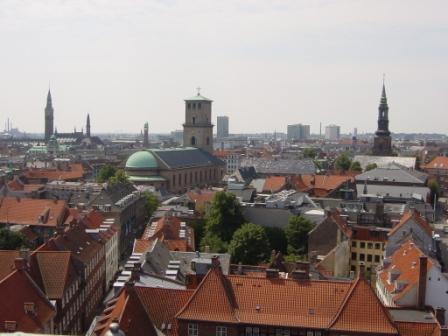

.>
There is a lot towers in my city.



.>
What is the truth about Dubai?
I have never heard so much hype about a city in my life. Every forum I go to, and not just at SkyscraperCity, there's some new thread about some mega project in Dubai. Nothing wrong with that, but I've always wondered if there just a bit too much megaphoning going on.
And then a friend of mine says that a lot of the buildings in Dubai are actually vacant. They were built, and now they sit there.
Can someone tell me if he was lying or is that a correct statement? If so, have developers in Dubai gone insane?
I really need some first-hand accounts on what is the truth about this.>
And then a friend of mine says that a lot of the buildings in Dubai are actually vacant. They were built, and now they sit there.
Can someone tell me if he was lying or is that a correct statement? If so, have developers in Dubai gone insane?
I really need some first-hand accounts on what is the truth about this.>
World Class Cities -- Round 2 --
I listed the survivors of the World Class Cities thread and added the leading candidates of European cities to the list.
Then which cities are world class?>
Then which cities are world class?>
Does hongkong culture underated?
as one of the famous international city,hk sometimes used to compare with other major city like big 3,of course,one thing that people should think about is hongkong culture csannot copmapre with other major city,and what cultural desert,lack of multiculturalism,lack of worldwide influence.even the tourist in China agree that.
as a city that could be consider the only modern city in China(rest of Chinese city is not so modern as people think,beside skyscraper,)and the culture mixture of traditional chinese and western culture
what do you think of hong kong culture?>
as a city that could be consider the only modern city in China(rest of Chinese city is not so modern as people think,beside skyscraper,)and the culture mixture of traditional chinese and western culture
what do you think of hong kong culture?>
Does Hong Kong cheat?
Does Hong Kong cheat in its rankings as a major skyscraper center?
Well, not intentionally, of course. But on appearances:
Hong Kong, unlike NYC and Chgo, is built on the slope of a mountain that is rather steep for an urban setting. Its impressive group of skyscrapers climb that slope, giving them an appearance of height far greater than what you would find in Midtown or the Loop.
Here in the US, San Francisco plays by the rules; the vast majority of its super tall buildings are close to the relatively flat Embarcadero or on slightly higher Montgomery Street inland. These structures tend to tower over the downtown hills (Telegraph, Nob, Russian); so different from Hong Kong.
If HK were "flattened", would its preceived high rise prominence get flattened, too? Talk about literally not playing on a level playing field!>
Well, not intentionally, of course. But on appearances:
Hong Kong, unlike NYC and Chgo, is built on the slope of a mountain that is rather steep for an urban setting. Its impressive group of skyscrapers climb that slope, giving them an appearance of height far greater than what you would find in Midtown or the Loop.
Here in the US, San Francisco plays by the rules; the vast majority of its super tall buildings are close to the relatively flat Embarcadero or on slightly higher Montgomery Street inland. These structures tend to tower over the downtown hills (Telegraph, Nob, Russian); so different from Hong Kong.
If HK were "flattened", would its preceived high rise prominence get flattened, too? Talk about literally not playing on a level playing field!>
Regional Air Pollution
Does your city suffer from an air pollution problem due to industry / activities in neighboring cities / countries?
Hong Kong suffers from an increasingly problematic air quality problem, of which about 80-90% of the haze is blown across the border from industries in southern China. Hong Kong businessmen are being urged to clean up their factories in the mainland to help reduce air pollution.
 >
>
Hong Kong suffers from an increasingly problematic air quality problem, of which about 80-90% of the haze is blown across the border from industries in southern China. Hong Kong businessmen are being urged to clean up their factories in the mainland to help reduce air pollution.
 >
>
World Competitiveness Rankings 2006
Quote:>
>Source : Finfacts>
Director of the World Competitiveness Project and Professor at IMD Business School and University of Lausanne, says that in 2006, competitiveness is a more compact race than ever before. Although the US is still No. 1 in IMDÂ's World Competitiveness Yearbook, other economies, especially Hong Kong and Singapore are closing the gap. Why? Garelli says that there is a striking difference between the achievements of the US economy in 2005 (3.5% growth) and the US$318bn budget deficit accumulated by the federal government and the US$8,000bn debt. Are some governments becoming a burden for competitiveness? Italy, France and some Latin American countries seem to be confronted with the same situation. Some governments fail to contribute to the overall competitiveness of their country. Ireland gets an 11th ranking and the UK at 21st place, is the top-ranked large economy in Europe.  IN THE LIMELIGHT IN 2006: ARE SOME GOVERNMENTS DRAGGING THEIR FEET? This year, IMD have also calculated the biggest negative differences between the contribution of the government and the contribution of the economy to the overall competitiveness of a country. In these calculations, the governments of Venezuela, Argentina, Brazil, Mexico and Italy show the weakest performance; they significantly lag behind their economic performance. They fail to perform on several fronts: budget deficits, debt, taxes, bureaucracy, etc. In some cases, like Venezuela and Argentina, the economy still performs well for external reasons, such as oil prices or exports. On the other hand, Brazil and Mexico remain weak for growth. Italy is the only country in the ranking with no economic growth in 2005!  USA and France are the two industrial nations that show the biggest difference between the performance of their governments and the performance of their economies. Budget deficits and debt are running higher in both countries, calling into question the efficiency of the State. Meanwhile, the US and France are still the 2nd and 5th largest exporters in the world thanks to very dynamic enterprises. In these two countries, business outperforms government. India and China face similar gaps between government and economic performance, but for different reasons. With growth rates of 8.1% and 9.9% respectively, both governments face the challenge of keeping pace with rapid economic expansion. Their task now is to meet the standards and expectations of a buoyant economy. Failure to do so may create economic and social imbalances that could jeopardize what has been achieved so far. The lesson here: success has a price. ARE GOVERNMENTS DRAGGING THEIR FEET? (Biggest negative difference between the governmentÂ's and the economyÂ's contribution to competitiveness)  IMDÂ's World Competitiveness Yearbook defines a nationÂ's environment by the contribution of four Factors of Competitiveness: Economic Performance, Government Efficiency, Business Efficiency and Infrastructure. Here it shows a comparison between the contributions of Economic Performance and Government Efficiency, calculating the biggest negative differences between the governmentÂ's and the economyÂ's contribution to the overall competitiveness of each country. To support and stimulate the competitiveness of their country, governments need to remain on top of economic imperatives. Hong Kong and Singapore are catching up with the US because their governments are more in synchronisation with economic performance. Finland and Denmark also fare well; others less. A growing gap between governments and economic performance is always a bad omen for the future, Professor Garelli says. What is the WCY? · Competitiveness of 61 national & regional economies, based on 312 criteria · Focuses primarily on Hard data (2/3 from international, regional and national sources) · Survey data (1/3) – from our annual WCY Executive Opinion Survey 2006 · Published annually since 1989 and updated twice a year on-line · Worldwide reference point with objective benchmarking · Reliable and up-to-date data with unique network of 58 Partner Institutes worldwide THE WORLD COMPETITIVENESS LANDSCAPE IN 2006 By Professor Stéphane Garelli |
Which of Asian cities will have the most empressive skyline by 2015?
Here are the most likely candidates.
Shanghai
Tokyo
Hong Kong
Guangzhou
Shenzhen
Chongqing
Beijing
Osaka
Manila
Bangkok
Kuala Lumpur
Singapore
Mumbai
Nanjing>
Shanghai
Tokyo
Hong Kong
Guangzhou
Shenzhen
Chongqing
Beijing
Osaka
Manila
Bangkok
Kuala Lumpur
Singapore
Mumbai
Nanjing>
Are Latin American countries cheaper alternatives to California?
Are Latin American countries cheaper alternatives to California?>
Urbanization in Dubai : 1973 > 2006
1973

1990

2006

less big:

Between 1973 and 2006 dramatic changes along the coast of the United Arab Emirates follow the development of Dubai, one of the countryÂ's seven emirates. The country is located along the eastern coast of the Arabian Peninsula where the land tapers to a sharp tip that nearly separates the Persian Gulf to the north from the Gulf of Oman to the south. This trio of images from NASAÂ's series of Landsat satellites shows the remarkable transformation.
Going back in time, the evidence of human engineering nearly vanishes. In the top image, captured on October 11, 2006, artificial islands shaped like palm trees stretch along the shore. Inland, irrigated vegetation stands out in red (the image is enhanced with infrared light) against the tan-colored desert. Developed areas, including numerous roads, appear cement-colored. In the middle image, captured on August 28, 1990, the number and density of roads and buildings is far less than in 2006. The area to the southwest of image center is particularly less developed. Going all the way back to January 22, 1973, the roads reaching into the desert from the coast are indistinct or absent. Very little development appears to exist along the coast. Empty sand stretches southwestward from the inlet in image center.
The city of Dubai is home to more than 1.2 million people, and it is still growing rapidly. The cityÂ's emergence as a major metropolis and tourist destination is evident in these images.
NASA images created by Jesse Allen, Earth Observatory, using data provided by Laura Rocchio,
 >
>

1990

2006

less big:

Between 1973 and 2006 dramatic changes along the coast of the United Arab Emirates follow the development of Dubai, one of the countryÂ's seven emirates. The country is located along the eastern coast of the Arabian Peninsula where the land tapers to a sharp tip that nearly separates the Persian Gulf to the north from the Gulf of Oman to the south. This trio of images from NASAÂ's series of Landsat satellites shows the remarkable transformation.
Going back in time, the evidence of human engineering nearly vanishes. In the top image, captured on October 11, 2006, artificial islands shaped like palm trees stretch along the shore. Inland, irrigated vegetation stands out in red (the image is enhanced with infrared light) against the tan-colored desert. Developed areas, including numerous roads, appear cement-colored. In the middle image, captured on August 28, 1990, the number and density of roads and buildings is far less than in 2006. The area to the southwest of image center is particularly less developed. Going all the way back to January 22, 1973, the roads reaching into the desert from the coast are indistinct or absent. Very little development appears to exist along the coast. Empty sand stretches southwestward from the inlet in image center.
The city of Dubai is home to more than 1.2 million people, and it is still growing rapidly. The cityÂ's emergence as a major metropolis and tourist destination is evident in these images.
NASA images created by Jesse Allen, Earth Observatory, using data provided by Laura Rocchio,
 >
>
Most Deceptive Cities
There are some cities that when you visit them or see pictures of them, they give the impression of being much larger or smaller than their metro population figures would suggest. Sometimes it's because the cities are unusually suburbanized or centralized, and in others it's because of geography, economy, or even just the style of architecture.
So what cities are the best examples of this?>
So what cities are the best examples of this?>
Most luxurious and expensive hotels in world?
Which one is it? And where is it located? Pics plz.....>
Toronto's WiFi Network is up and running
But alas, will be free for only 6 months or so.
http://tinyurl.com/z577m
Limited to a couple of square miles of downtown right now, but planned to cover the entire "city" within three years. What they mean by "city" isn't clear, but if it is the 240 square mile core (old city plus original boroughs), kudos to them.
They first announced this just a short number of months ago, and I was skeptical at first, but heck, it looks like they mean busiess.>
http://tinyurl.com/z577m
Limited to a couple of square miles of downtown right now, but planned to cover the entire "city" within three years. What they mean by "city" isn't clear, but if it is the 240 square mile core (old city plus original boroughs), kudos to them.
They first announced this just a short number of months ago, and I was skeptical at first, but heck, it looks like they mean busiess.>
Largest city without any homicides
Does anybody know what's the world's largest city that didn't record any homicides in 2005?
In the US I think it was Irvine in California which has around 180,000 people.>
In the US I think it was Irvine in California which has around 180,000 people.>
London: ugly or beautiful?
Reading different threads, I've noticed how varied opinions can be regarding London's beauty. Some people call it stunning and some say it's hideous. I just wanted to know what your thoughts were on why opinions on some cities like Paris can be so sure ( I've never heard anyone call Paris ugly) and why opinions about cities like London's aren't. It would be great if you gave your opinion about London, but lets please not turn this into a pissing contest.>
Tall Trees...why you won't see them in (new) suburbs
From: http://www.thestar.com/NASApp/cs/Con...2154&t=TS_Home
__________________________
__________________________
Quote:>
>>
| Why suburbs will never have tall trees May 7, 2006. 07:18 AM KENNETH KIDD Drive through the outer suburbs of Toronto, and chances are you'll find a familiar scene, one replicated across the continent. Behind the signs announcing a new subdivision, monstrous tractors and earth-moving equipment will be chugging across the landscape, preparing what might have been a farmer's field for a sea of houses. Off to one side, there'll be a giant pile of earth — all of the topsoil that had been scraped away and set aside so the machines could grade the site for drainage, sewers and roads. Then the houses duly go up, some of that topsoil gets put back for the lawns, and in come the happy new homeowners dreaming of a green and leafy suburb to be. There's just one snag: It may be decades before the place will begin to support the kind of trees the homeowners want. "It's really not the first generation of trees that's going to be this spectacular canopy that you see in those old neighbourhoods of any town or city," says Richard Ubbens, chief of urban forestry for Toronto. "It's going to be the second generation that starts to form that canopy." In other words, it could take more than a century — and generations of homeowners — before that subdivision starts looking like verdant Riverdale. The problem: The kind of soil that trees need and the way they actually grow both happen to run counter to a lot of popular misconceptions, and headfirst into modern building techniques. This is why Todd Irvine, an urban forestry consultant with Bruce Tree Expert Company Ltd. in Toronto, is pointing to his forearm. When they're small, "Roots are as small as the hairs on my arm," he says, "and people don't necessarily realize that. They think of them as these big things pushing through cement, and they're not." In order to grow, the roots of trees need soil that contains a lot of oxygen and free space, not just water and nutrients. They also need room — or rather, a special kind of room. The roots don't go very deep, with most of them in the top 60 cm or so. So they try to spread out as far on all sides as the tree is tall. Now consider what's happened at the subdivision. Once the topsoil is removed, you're left with the rock and clay underneath, which hasn't seen the light of day for thousands of years. Landscapers call it "hardpan," and from an engineering point of view it's an ideal material to mould into the site's drainage plan. Run heavy equipment over material like that, and it quickly gets compacted into something with much the same consistency as concrete. Once the houses are in place, the topsoil gets put back, but usually to a depth of only 20 cm., which is the typical municipal standard and enough to support healthy turf. The rest of the stockpiled topsoil is usually sold off and eventually ends up in nurseries, but only after it's been rehabilitated by adding manure or peat moss or sand. That's because the soil became anaerobic after sitting in a pile for so long. "There's no oxygen within that pile anymore, and eventually all the living microbes and organisms in that soil die," says Ubbens. So you end up with less-than-ideal topsoil spread thinly over a layer of clay hardpan that often includes pieces of brick and other debris. "In our business, we call it `builder's loam,'" says Ubbens. "It's unfortunate that it's so bad that it's even got a name." Planting trees in that is like sticking them in a clay pot. "We bore a hole in that heavily compacted clay, put the tree in with a certain amount of soil, but the tree will eventually start to decline," says Andy Kenney, senior lecturer in urban and community forestry at the University of Toronto. Sometimes, those holes can fill up with water, drowning the tree. Or the roots, unable to penetrate the surrounding clay, will keep circling around and end up girdling themselves. Even those that manage to survive will be stunted. Irvine's parents live in a Mississauga house built in the early 1970s as part of a new subdivision, for instance. It used to be an apple orchard, and not long after the houses went up, in came new trees planted in the boulevard. "There are Norway maples in front of their house that should be 50, 60 feet tall," he says. "They're 10, 12 feet tall." Why then, are the trees in places like Riverdale, High Park or the Beach so tall? It's partly a function of how the houses were built, and the technology available a century ago. Armed with only small steam shovels, horses and manpower, developers essentially plopped houses onto the existing terrain. The original grade of the land, and much of soil, was left untouched, and a lot of the existing trees were spared, says Ubbens. "So you have these unique communities in older parts of towns and cities, not just Toronto but all over the place, where one house is higher than the next because there were hills and valleys and little undulations in the terrain." That's why older neighbourhoods had to be dotted with little pumping stations to handle water and sewage, which wouldn't otherwise flow the way it needed to go, and why there'd be variations in water pressure. Quaint in the city, perhaps, but not the kind of selling point that gets highlighted in the brochures for a new subdivision. There was another advantage in the way builders operated back then. Not just the soil, but the structure of the soil was left intact. The ideal planting medium, says Ubbens, also includes a gradual transition from the topsoil down to the underlying material, rather than a sharp divide between topsoil and the more mineral-laden soil underneath. That transition has been built up through the work of decaying plant material, frost, worms and the like. Recreating it isn't easy. "If you're dealing with a clay soil, that soil can be pretty hard and tough, and it can take decades and decades before you have any kind of decent soil profile again," says Ubbens. To wit: his own house in Rexdale, built a half-century ago. "I'm starting to see a little bit of soil profile around my place," says Ubbens. "My piece of property was graded, originally, so I'm not one of the lucky ones." Some trees grow well on less hospitable sites, such as ashes and honey locusts, which is why you tend to see a lot of those in new subdivisions. And there have been surprises. Silver maples usually do well in wet soils but somehow seem to survive in drier, compacted soils. One theory, says Kenney, is that with their normally wet feet, these maples were already adapted to deal with lower levels of oxygen in the ground. But relying on a relatively limited number of species has its own potential problems. The number of ashes that have been planted, for instance, is an open invitation to the emerald ash borer, now wreaking havoc around Windsor and working its way east. Tony DiGiovanni figured he knew better when he bought his house in Newmarket. He is, after all, the executive director of Landscape Ontario, the umbrella body for the landscaping industry. "I was smart enough when I went to buy the house that I put in the offer that I wanted a foot of topsoil. "First of all, the agent looked at me as if I was crazy, and I said, `No, I want a foot of topsoil.' It really doesn't cost that much to put a foot of topsoil on." It proved a fleeting victory. "What happened was that, after the topsoil was down, they drove these huge machines over it, so they compacted it like cement anyway." DiGiovanni ended up having to till it all up himself and bring in additional topsoil. "In retrospect, I look at it and say, `You know, it's impossible for these guys to build the way they build without these machines,'" he says. "You need the machines." There are solutions, but soil quality isn't top of mind for most homebuyers, if it occurs to them at all. It's all hindsight. "If they knew they were buying a house where it was going to be that difficult to grow things, I think a lot of homeowners wouldn't be happy about that," says Irvine. "They just think they're going to get soil, and soil is soil is soil. But it's not." Nor has soil got a lot of attention from municipalities and homebuilders. The Greater Toronto Homebuilders Association, for example, doesn't have any soil guidelines. It relies instead on the municipal standards in various communities, which are only now being revised to be more tree-friendly. In Toronto, Ubbens says his department is pushing to have the minimum topsoil standard raised to 30 cm., or about a foot, from the current 20 cm. But he knows policing any new standards will be tough. "I don't have the staff to go onto private property and supervise the installation of top soil." And the ultimate solution — machines called "sub-soilers" — won't be common anytime soon. There are a variety of sub-soilers, but the basic idea is the same. Think of a giant tooth cutting a metre into the earth and vibrating, breaking up all that compacted soil. The City of Toronto uses them on its new planting sites, then mixes in additional peat moss or sand before putting about 15 cm. of mulch on top. "What you get is this incredible root growth," says Ubbens. "It just allows the roots to get down and get established very, very quickly." DiGiovanni doesn't need convincing. "Sometimes, I think if we could just do one thing to improve the environments in subdivisions, it's the sub-soiler." But sub-soiling is expensive, and it has to be done after the houses have been constructed, so you have to worry about cutting into any underground utilities. "I don't know anybody who's doing it now," says DiGiovanni. As Irvine puts it: "Arborists are pretty low on the totem pole. You have a site where you have architects, engineers, lawyers, urban planners, traffic consultants. "Arborists don't have that clout. But if we want to live in healthy neighbourhoods, a big component of that is big trees." |
The world's most empressive skylines: new method
Hi!
I created a new method to estimate an impressiveness of skylines all over the world. I used the data from Emporis and Skyscraperpage sites. I take into account only top 50 buildings from each city and only built buildings. I summed up the heights of top 50 buildings (R1) and separately summed up the heights of top 25 buildings (R2). Than, to appreciate the city with very high buildings as compared with the rest of buildings in a city (such as Seattle, Los Angeles), cities with downtowns, which look more impressive as compared with the cities with scattered buildings with the same height (such as Sao Paolo, Curitiba, Rio de Janeiro), I intoduced a coefficient: for R1 -1, for R2- 2.
The Formula R= (R1+R2*2)/3
Look what I made.
TOP 50 CITIES.
1 Hong Kong 9041
2 New York 8877
3 Chicago 8522
4 Shanghai 8334
5 Tokyo 7500
6 K Lumpur 7350
7 Shenzhen 7252
8 Singapore 7173
9 Houston 7133
10 Dubai 7081
11 Guanzhou 7080
12 Seoul 6928
13 Bangkok 6876
14 Chongqing 6792
15 Sydney 6656
16 L Angeles 6637
17 Manila 6610
18 Melbourne 6576
19 Dallas 6276
20 Toronto 6211
21 Atlanta 6177
22 S Francisco 6084
23 Osaka 5992
24 Nanjing 5975
25 Boston 5828
26 Jakarta 5826
27 Tianjin 5779
28 Philadelphia 5758
29 Moscow 5676
30 Seattle 5670
31 Wuhan 5646
32 Beijing 5545
33 Panama 5467
34 Calgari 5455
35 Miami 5453
36 Dalian 5452
37 Paris 5437
38 Rio de Jan. 5388
39 Curitiba 5370
40 Mexico 5352
41 Montreal 5323
42 Busan 5304
43 Frankfurt 5279
44 Sao Paolo 5278
45 Macao 5147
46 Istanbul 5125
47 B Aires 5111
48 Caracas 5111
49 London 5080
50 Brisbane 5006>
I created a new method to estimate an impressiveness of skylines all over the world. I used the data from Emporis and Skyscraperpage sites. I take into account only top 50 buildings from each city and only built buildings. I summed up the heights of top 50 buildings (R1) and separately summed up the heights of top 25 buildings (R2). Than, to appreciate the city with very high buildings as compared with the rest of buildings in a city (such as Seattle, Los Angeles), cities with downtowns, which look more impressive as compared with the cities with scattered buildings with the same height (such as Sao Paolo, Curitiba, Rio de Janeiro), I intoduced a coefficient: for R1 -1, for R2- 2.
The Formula R= (R1+R2*2)/3
Look what I made.
TOP 50 CITIES.
1 Hong Kong 9041
2 New York 8877
3 Chicago 8522
4 Shanghai 8334
5 Tokyo 7500
6 K Lumpur 7350
7 Shenzhen 7252
8 Singapore 7173
9 Houston 7133
10 Dubai 7081
11 Guanzhou 7080
12 Seoul 6928
13 Bangkok 6876
14 Chongqing 6792
15 Sydney 6656
16 L Angeles 6637
17 Manila 6610
18 Melbourne 6576
19 Dallas 6276
20 Toronto 6211
21 Atlanta 6177
22 S Francisco 6084
23 Osaka 5992
24 Nanjing 5975
25 Boston 5828
26 Jakarta 5826
27 Tianjin 5779
28 Philadelphia 5758
29 Moscow 5676
30 Seattle 5670
31 Wuhan 5646
32 Beijing 5545
33 Panama 5467
34 Calgari 5455
35 Miami 5453
36 Dalian 5452
37 Paris 5437
38 Rio de Jan. 5388
39 Curitiba 5370
40 Mexico 5352
41 Montreal 5323
42 Busan 5304
43 Frankfurt 5279
44 Sao Paolo 5278
45 Macao 5147
46 Istanbul 5125
47 B Aires 5111
48 Caracas 5111
49 London 5080
50 Brisbane 5006>
The future: San Francisco, Man, & Nature
It would be a total understatement to say that San Francisco is a unique American city with a totally unique look. There is no place like it.
What fascinates about this incredible city is its uncanny ability to combine the beauty of man with the beauty of nature...and improving on both. The natural setting: the bay serving as amphitetheatre in the center, surrounded by hills and mountains with the Pacific to the west and the Golden Gate connecting the two. Pure enchantment.
San Francisco has taken its peninsular location and enhanced with its white washed, Mediterannean look....the pastels, the bay windows, the mixture of victorian and red tiled stucco. You can look at a pictue of a San Francisco neighborhood and identifying it, knowing it could be no where else.
Even in an era when commercial forces put pressures on cities, SF has gotten better, not worse. It fought freeways, restricted their growth and used an earthquake to tear some down. Even unquestionably dark buildings (like B of A) and come-look-at-me ones like the Transamerica Pyramid, after contraversial starts are embraced as intregal parts of the city.
Yet the future is open ended...and more and more change will come.
So here's my question: IS SAN FRANCISCO (AND, IN EXTENSION, THE WHOLE ENCHANTED BAY AREA) CAPABLE OF MAINTAINING THE MAN MADE END OF THINGS TO MATCH THE NATURAL?
The skyline that once followed the flow of the downtown hills (Nob, Russian, Telegraph) now overpowers it and blocks views.
What will the future bring? Will there be a pressure for added density that could seriously affect views and neighborhood character? Will the unique SF style of design always be protected in future construction? Will the man made contribution to San Francisco keep up with nature's contributions?>
What fascinates about this incredible city is its uncanny ability to combine the beauty of man with the beauty of nature...and improving on both. The natural setting: the bay serving as amphitetheatre in the center, surrounded by hills and mountains with the Pacific to the west and the Golden Gate connecting the two. Pure enchantment.
San Francisco has taken its peninsular location and enhanced with its white washed, Mediterannean look....the pastels, the bay windows, the mixture of victorian and red tiled stucco. You can look at a pictue of a San Francisco neighborhood and identifying it, knowing it could be no where else.
Even in an era when commercial forces put pressures on cities, SF has gotten better, not worse. It fought freeways, restricted their growth and used an earthquake to tear some down. Even unquestionably dark buildings (like B of A) and come-look-at-me ones like the Transamerica Pyramid, after contraversial starts are embraced as intregal parts of the city.
Yet the future is open ended...and more and more change will come.
So here's my question: IS SAN FRANCISCO (AND, IN EXTENSION, THE WHOLE ENCHANTED BAY AREA) CAPABLE OF MAINTAINING THE MAN MADE END OF THINGS TO MATCH THE NATURAL?
The skyline that once followed the flow of the downtown hills (Nob, Russian, Telegraph) now overpowers it and blocks views.
What will the future bring? Will there be a pressure for added density that could seriously affect views and neighborhood character? Will the unique SF style of design always be protected in future construction? Will the man made contribution to San Francisco keep up with nature's contributions?>
World's Fairs, Olympics, and Other Big Ticket Events
We often associate a particular city with a particular event - New York and their World's Fairs, Barcelona and the Summer Olympics, and Seattle and it's World Fair.
Yet it seems that recently a number of those cities have lost money on those types of world stage events. Is this a result of simply poor planning or staging, or is it a sign that these events have outlived their usefullness? Do these events still have something to offer the host city, and who would most likely benefit from them?>
Yet it seems that recently a number of those cities have lost money on those types of world stage events. Is this a result of simply poor planning or staging, or is it a sign that these events have outlived their usefullness? Do these events still have something to offer the host city, and who would most likely benefit from them?>
World's tallest skylines by their top 10 - top 20 tallest skyscrapers
*The poll are multiple choices for the world's tallestes skylines with their top 10 to 20 tallest skyscrapers!
Ok, this is by no mean to determine the impressiveness of the city skylines, nor does it show the world's best skylines, because they have something based on viusal impact and personal preferences!
So I found out about Ultrapolis Project which they based on city skyline's top 10 tallests with no means to set the abosolute cut off for the most highrises,but to show the supertalls in the world that are distributing within certain cities like Chicago, HK, KL, NYC, Shanghai....ects! Their stats for adding the top 10 tallests for each city skyline are based on emporis.com. How about top 20 to 50 well, Yurist has came up a formula for every cities top 50 to measure the highest skyline of every cities in the world, but the results are based on 50 tallest in each cities so it also accounted the highrises as well as mid-low rises(cities like Sao Paulo, Rio, SA, Taipei, Beijin...ect), So more top buildings are account for, the least of clear tallness resulted from the calculation because some cities simpily averaging low in overall heights. So IMHO, to clearly see the world's tallest skyline, the higher the top tallest buildings the better, so something like top 10 to top 30 can possibily show the skyline that really has huge bump in its skyline height.
Feel free to post pix of tallest skylines in the world in distant view with their top 10 to 20 skyscrapers clearly appear above the rest of skyline or overshadow or top out over the rest of buildings in the skyline! You know the skylines in the world that scream out "extremely tall" from distant!
For example:
Chicago-world's tallest supertall skyline(Clearly shows its top 10 to 20 tallest skyscrapers above the rest of highrises, because what we are looking for is "tallest supertalls" skylines in the world as oppose to "most highrises" skylines!)

Here is its methodology for the world's tallest skylines:

Currently world's tallest skyline in the world based on top 10 tallest in the skyline:
#1:Chicago
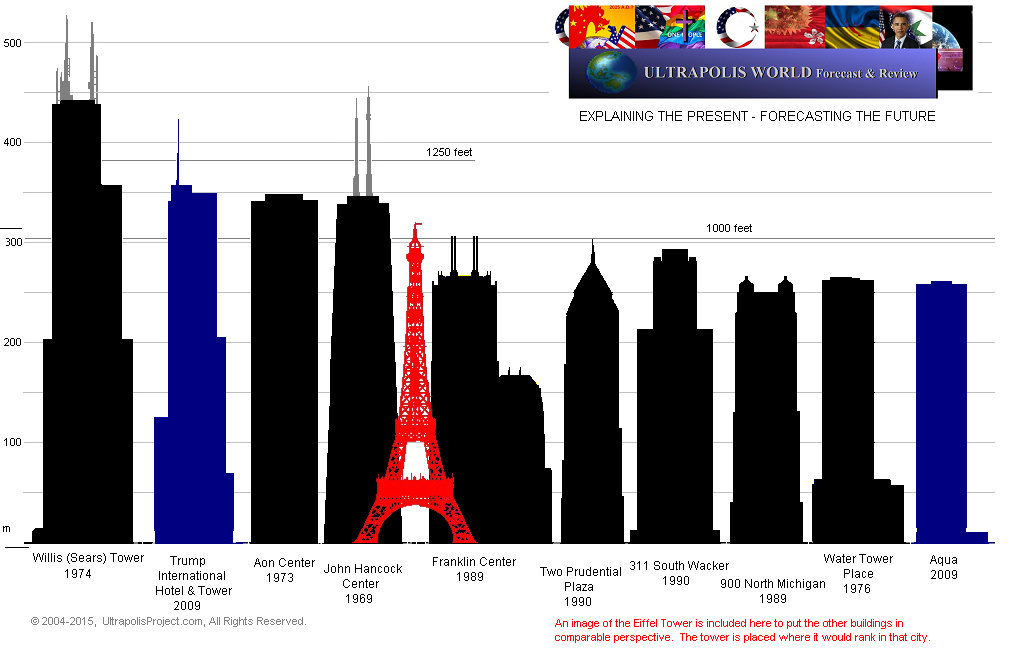
#2:HK

#3:KL

#4:NYC

#5:Shanghai

#6 ubai
ubai
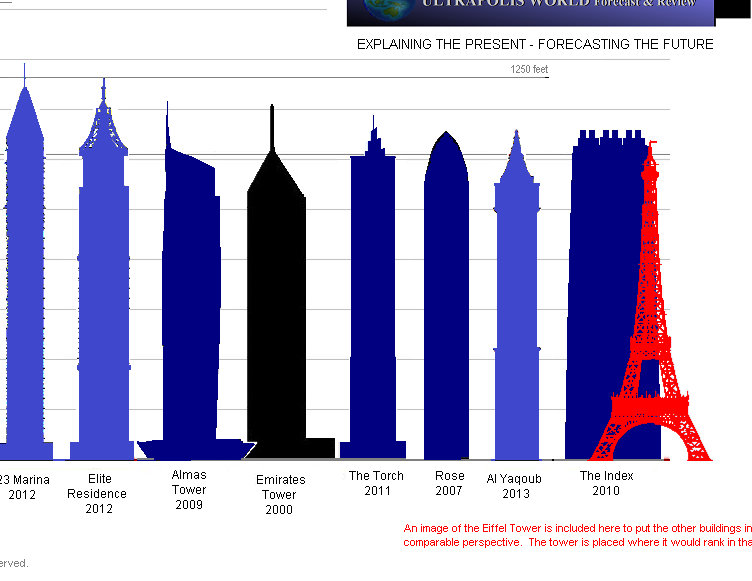
#7:Houston

#8:Shenzhen

#9:Toronto

#10:Singapore

#27:Taipei(Just to show that currently having 1 world's tallest building in the world doesn't show the overall impressiveness of its top 10 skyscrapers or even top 50)

I included a poll to see what you think about world's tallest skylines based on their top 10 - top 20 tallests, multiple choices!
Update on 2005 ranking:
In determining the rankings of the world's 25 tallest cities as of December 31, 2005, we continued to find that almost all of the construction of supertall skyscrapers is in Asia (for images of the top ten, click top left button - for full list of top 25, click lower left button). Of the ten tallest cities of 2004, three - Shanghai, Shenzhen, and Toronto - introduced in 2005 new buildings into their ten tallest, slightly raising their scores for 2005. However, in the major skyscraper development of the year, and probably the decade, one city that was not in the top ten as of the end of 2004, added an astonishing five new buildings to their top ten. These were of enough verticality to catapult the city from 14th place in 2004, just behind Atlanta, to 6th place for 2005, just above Houston. Consequently, Houston, Shenzhen, Toronto, Singapore, and Los Angeles all moved down one place in the rankings, leaving Los Angeles out of the top ten (at one time the 4th tallest city in the world).
The city is Dubai, of the United Arab Emirates; and with a population smaller than that of Dallas, it is undergoing a construction boom the likes of which has not been seen possibly since the building boom eight decades ago in New York City (see related article). If the current trend continues, and the all the buildings currently under construction do materialize as planned, by the end of the decade the city of Dubai will become the tallest, and most fantastic city the world has ever seen. By then, even New Yorkers will be drawn to modesty should they happen to set their eyes upon the new gleaming city at the edge of the Arabian desert.
But, there is a question as to the feasibility of this development. After all, one wonders how a city of a 1,200,000 will support, and fill, an array of skyscrapers normally found in rich cities seven times as big. In any case, as the related article notes, Dubai is set on completing the world's tallest building even before New York's much delayed Freedom Tower has a chance to claim the title. This is the same Dubai of Dubai World Ports that soon, barring an act of the U.S. Congress, will be running America's major ports, including the ports of New York and New Orleans; the same Dubai that in a span of a few years has become a major world banking and financial center, tourist destination, and the main air transportation hub in the Middle East.
Other top height-gainers of 2005 were the Chinese cities of Wuhan, moving from 25th to 19th place, and Chongqing, advancing from 28th to 20th, reflecting the continuing dramatic growth of the economic might of China.>
Ok, this is by no mean to determine the impressiveness of the city skylines, nor does it show the world's best skylines, because they have something based on viusal impact and personal preferences!
So I found out about Ultrapolis Project which they based on city skyline's top 10 tallests with no means to set the abosolute cut off for the most highrises,but to show the supertalls in the world that are distributing within certain cities like Chicago, HK, KL, NYC, Shanghai....ects! Their stats for adding the top 10 tallests for each city skyline are based on emporis.com. How about top 20 to 50 well, Yurist has came up a formula for every cities top 50 to measure the highest skyline of every cities in the world, but the results are based on 50 tallest in each cities so it also accounted the highrises as well as mid-low rises(cities like Sao Paulo, Rio, SA, Taipei, Beijin...ect), So more top buildings are account for, the least of clear tallness resulted from the calculation because some cities simpily averaging low in overall heights. So IMHO, to clearly see the world's tallest skyline, the higher the top tallest buildings the better, so something like top 10 to top 30 can possibily show the skyline that really has huge bump in its skyline height.
Feel free to post pix of tallest skylines in the world in distant view with their top 10 to 20 skyscrapers clearly appear above the rest of skyline or overshadow or top out over the rest of buildings in the skyline! You know the skylines in the world that scream out "extremely tall" from distant!
For example:
Chicago-world's tallest supertall skyline(Clearly shows its top 10 to 20 tallest skyscrapers above the rest of highrises, because what we are looking for is "tallest supertalls" skylines in the world as oppose to "most highrises" skylines!)


Here is its methodology for the world's tallest skylines:

Currently world's tallest skyline in the world based on top 10 tallest in the skyline:
#1:Chicago

#2:HK

#3:KL

#4:NYC

#5:Shanghai

#6
 ubai
ubai
#7:Houston

#8:Shenzhen

#9:Toronto

#10:Singapore

#27:Taipei(Just to show that currently having 1 world's tallest building in the world doesn't show the overall impressiveness of its top 10 skyscrapers or even top 50)

I included a poll to see what you think about world's tallest skylines based on their top 10 - top 20 tallests, multiple choices!

Update on 2005 ranking:
In determining the rankings of the world's 25 tallest cities as of December 31, 2005, we continued to find that almost all of the construction of supertall skyscrapers is in Asia (for images of the top ten, click top left button - for full list of top 25, click lower left button). Of the ten tallest cities of 2004, three - Shanghai, Shenzhen, and Toronto - introduced in 2005 new buildings into their ten tallest, slightly raising their scores for 2005. However, in the major skyscraper development of the year, and probably the decade, one city that was not in the top ten as of the end of 2004, added an astonishing five new buildings to their top ten. These were of enough verticality to catapult the city from 14th place in 2004, just behind Atlanta, to 6th place for 2005, just above Houston. Consequently, Houston, Shenzhen, Toronto, Singapore, and Los Angeles all moved down one place in the rankings, leaving Los Angeles out of the top ten (at one time the 4th tallest city in the world).
The city is Dubai, of the United Arab Emirates; and with a population smaller than that of Dallas, it is undergoing a construction boom the likes of which has not been seen possibly since the building boom eight decades ago in New York City (see related article). If the current trend continues, and the all the buildings currently under construction do materialize as planned, by the end of the decade the city of Dubai will become the tallest, and most fantastic city the world has ever seen. By then, even New Yorkers will be drawn to modesty should they happen to set their eyes upon the new gleaming city at the edge of the Arabian desert.
But, there is a question as to the feasibility of this development. After all, one wonders how a city of a 1,200,000 will support, and fill, an array of skyscrapers normally found in rich cities seven times as big. In any case, as the related article notes, Dubai is set on completing the world's tallest building even before New York's much delayed Freedom Tower has a chance to claim the title. This is the same Dubai of Dubai World Ports that soon, barring an act of the U.S. Congress, will be running America's major ports, including the ports of New York and New Orleans; the same Dubai that in a span of a few years has become a major world banking and financial center, tourist destination, and the main air transportation hub in the Middle East.
Other top height-gainers of 2005 were the Chinese cities of Wuhan, moving from 25th to 19th place, and Chongqing, advancing from 28th to 20th, reflecting the continuing dramatic growth of the economic might of China.>
Subscribe to:
Comments (Atom)
Powered by Blogger. DownRight Blogger Theme v1.4 created by (© 2007) Thur Broeders
